CHAPTER 2C
GRAINS INTRODUCTION
Grains have been used for thousands of years as a main provider of food, energy and nourishment. The discovery of grains as a source of food by primitive people enabled them to settle in one place and rely on a food supply from the ‘crop that did not wander’. People shared the task of crop cultivation until such time when machinery took over.
Nowadays, some people rarely eat whole grains. Processed and refined foods have flooded the food aisles, and as they are great profit-making foods, advertising of them is both competitive and compelling. Breakfast cereals can make giants out of dwarfs, biscuits can become the mother’s best helper and white bread can be so spongy that the more you eat, the more flexible and active you become—well, that’s advertising!
Grains are a compact carbohydrate food, an energy source. For many people, their regular diet will include only one main grain, usually wheat, often in the form of sandwiches. Rice is also a common addition to the diet; however, the other grains rarely get a chance to contribute their nutritional benefits and unique taste.
The routine of modern-day living can have a detrimental effect on health. Time goes so quickly in the morning before work or school that some people compensate by relying on the quickest and most convenient packaged breakfast foods.
Be prepared for breakfast and give the whole grains a chance to make your day complete. You need energy to get through a busy day and breakfast is the ideal time to obtain the stamina of whole grains. Grains supply long-lasting energy, and apart from being an excellent source of carbohydrates, they also supply a fair percentage of primary protein.
At least two meals a day should be based around whole grains. There are many forms of the whole grain, some of which are seldom included or even thought of as a substitute for the commercially prepared and refined breakfast cereals. A rolled grain is a whole grain, with all the essential nutrients in proper balance.
The following pages provide a detailed nutritional survey of the main whole grains: barley, corn, millet, rice, rye and wheat, providing the best attributes of each whole grain and their products, with negative factors also mentioned.
The balanced diet requires approx.50% carbohydrates. Whole grains provide approx.70–80% carbohydrate content, 10% protein and a low fat content of 5%. Therefore, such foods as milk, cheese, butter, cream and oil can be added to grains, moderately, without problems.
Most grains need added fats to make them appetising, such as the basic bread and cheese combination. In addition, fats lower the glycemic index, providing a slower release of the starch content into glucose.
Refined grains lack valuable fibre and nutrients plus they increase blood sugar levels quickly, as they are mainly starch. Refer to the chart in section entitled as What is Carbohydrate. Whole grains are the ideal energy food with stamina power and a great supply of life-supporting nutrients. In section entitled as Wheat provides a guide to the daily intake of grains as part of a balanced diet.
Serve up the full benefits and flavour of whole grains today; they’re ace!

NOTE: All amounts in this book are measured in milligrams (mg) per 100 grams, unless stated otherwise.
| GLYCEMIC | C. P. L. | CALORIES – total: 354 kcal. per 100 grams |
| INDEX: 25 | 82 13 5 | Calories from: Carb: 290 Protein: 45 Fat: 19 |
BARLEY BARLEY – Hordeum vulgare
Barley had already made its name in history, long before wheat and rye, as it was used by the Egyptians over 8000 years ago. Barley grain was also used for the daily bread of Greek, Roman, Chinese and Hebrew civilisations from 4000 BC onwards, and it was also traded as payment for a day’s work.
Today, barley is mainly used for the brewing of beer, vinegar and whisky. The true value of barley’s unique nutritional qualities and flavour is untapped.
The best way to obtain barley in the diet is from barley grass juice. This is very similar to wheatgrass juice in healing power (refer to section entitles as Wheatgrass juice & sprouts).
Barley sprouts have helped in the discovery of nations: Captain Cook recognised that sprouted grains protected his hard-working men from illness, especially scurvy. Barley sprouts make an excellent addition to bread, casseroles and soups such as the classic Scotch broth.
Barley flakes or rolled barley are ideal for winter porridge, and when blended, for vegetarian pâté. Barley provides a unique body-warming effect and it was ‘the fast food’ for athletes and gladiators during the Roman empire.
Barley has the ability to decrease the risk of colon cancer, as the barley fibre promotes the growth of ‘friendly’ bacteria in the colon. Beneficial fatty acids, termed butyric acids, are formed which promote colon health by stimulating cells. These beneficial bacteria also retard the action of harmful bacteria. In addition, the good supply of the mineral selenium is known to protect against colon cancer.
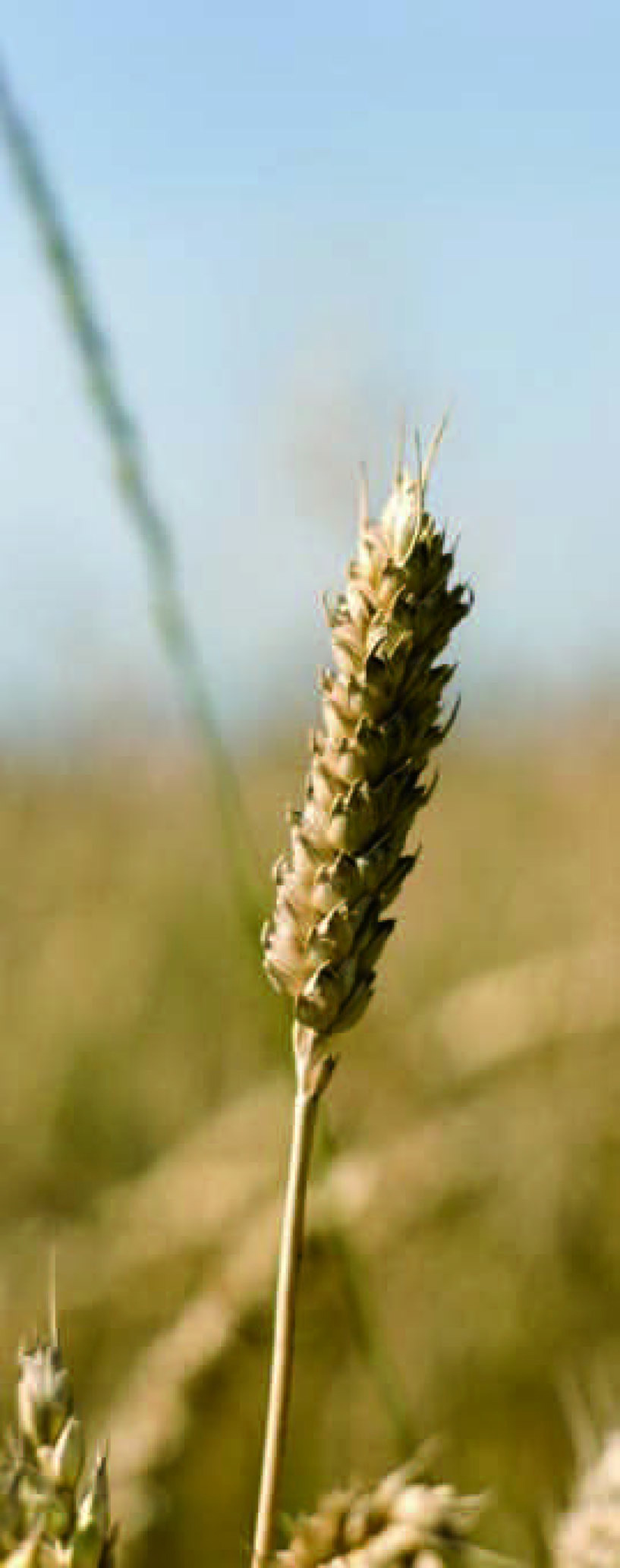
Barley fibre is also a good source of beta glucan which helps eliminate bile acids, produced by the liver and stored in the gall bladder to process fats. The removal of bile actually lowers blood cholesterol, as the liver will utilise stored cholesterol in the manufacture of more bile acids. Barley will provide approx.60% of the daily dietary fibre from 1 cup of cooked rolled barley and nearly 20% of daily protein when combined with milk. Rolled barley is best pre-soaked in water overnight and cooked for breakfast with milk added. If you have to add a dash of sugar, don’t worry, as the barley fibre slows blood sugar levels. However, barley is rich in maltose, or malt sugar, providing good natural sweetness.
The supply of organic copper from barley is ideal for the health of the joint system, the blood vessels and the skeletal system. A 1-cup serve of barley provides over 25% of daily copper requirements.
A rolled barley breakfast will protect against rheumatoid arthritis, due to its good supply of copper, while the phosphorus content (296mg) is abundant and beneficial for the brain and nervous system, in addition to magnesium (37mg).
Barley water has proved beneficial for asthmatics as it contains the substance hordenine, an antispasmodic. It can be made by boiling barley grains for 1 hour, then allowing to cool before drinking the water.
Be brave: try barley for breakfast, and in winter, place a pot of barley grains on the stove and get the true old-fashioned slow-cooked flavour: simmer for 2 hours for soups, just add your vegies, spices and herbs in the last 20 minutes.
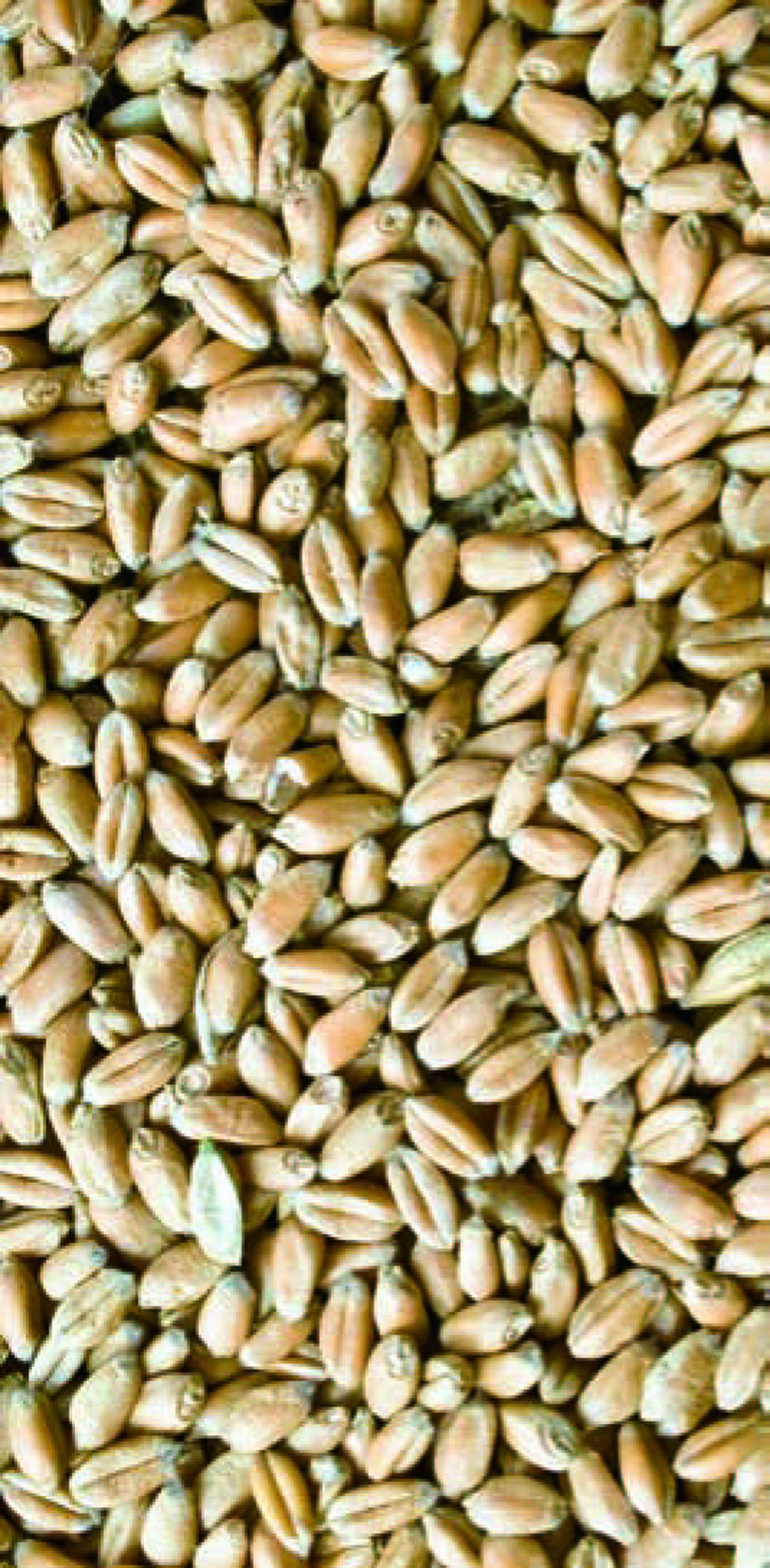
Barley brings a bounty of beautiful body benefits!
NOTE: d.v. refers to the daily value for women 25–50 years, refer to RDI chart for adult male and child values.
| GLYCEMIC | C. P. L. | CALORIES – total: 365 kcal. per 100 grams |
| INDEX: 56 | 82 7 11 | Calories from: Carb: 300 Protein: 26 Fat: 39 |
CORN/MAIZE
Corn is the ‘daughter of life’ according to the American Indians, and for 10,000 years it was their staple grain. In Mexico it provided the daily bread ‘tortilla’ and in North America ‘hominy’. Corn was exported to China, Africa, Japan and India during the 16th century, but, it was ‘scorned’ when compared to wheat and rye for breadmaking.
Corn flour contains no gluten and is low in 2 essential amino acids: tryptophan and lysine. In addition to this, niacin in corn flour is poorly absorbed.
There are 5 main types of corn: dent corn is used for breadmaking; flint corn for animal fodder; flour corn is the best quality for breadmaking, pop corn is the most popular and least nutritious; and the wonderful sweet corn is by far the most nutritious and delicious. Sweet corn, also known as ‘corn on the cob’, is full of benefits: the folate content (19mcg) is a great bonus for children or people who don’t like to eat their greens. Folate is vital for healthy growth in children, essential during pregnancy and also for the brain and nervous system.
Sweet corn is the best grain source of vitamin A (400 IU), and this combined with the top sulphur content (368mg) will protect the body against infections, especially when eaten raw or with light steaming.
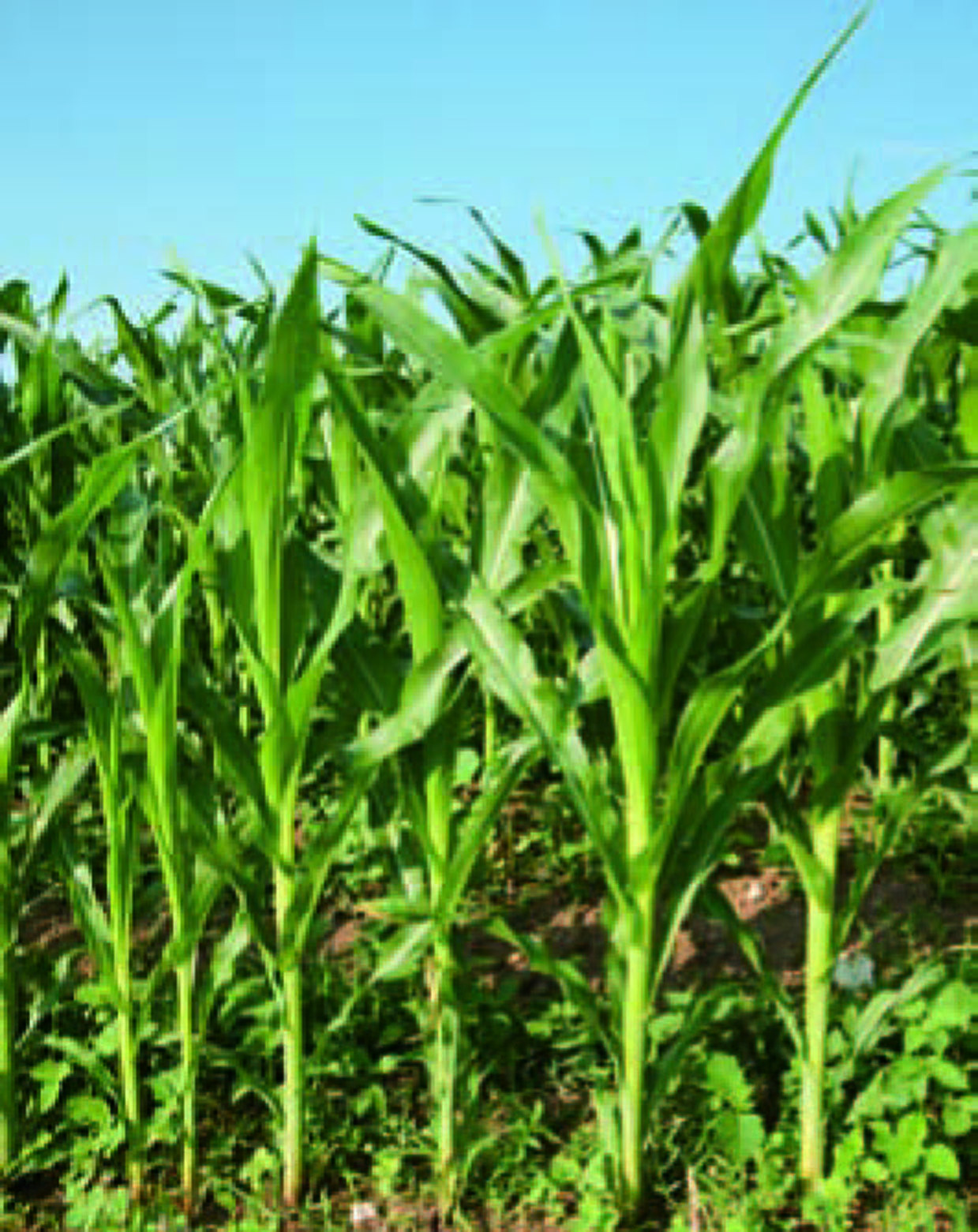
The vitamin A is mainly in the form of beta-cryptoxanthin, a carotenoid. One report showed a 37% reduction in the risk of lung cancer in smokers for those who regularly consumed beta-cryptoxanthin rich foods.
Sweet corn is a good source of potassium (280mg), and for those irritable children with a sweet tooth, a cob of corn for an after-school snack might hit the spot. The magnesium (48mg) might be just enough to help them concentrate and be creative with their homework too! Sweet corn is a natural treat with a very low calorie (96) and fat content (1g), so add a dab of butter and get eating. It is available nearly all year round, but it’s best and sweetest in summer.
The vitamin C (12mg) plus the good supply of fibre (0.07g) both add to the benefits of sweet corn. Unlike flour corn, it contains a good supply of vitamin B3 (1.7mg) and this, combined with the phosphorus and magnesium content, means sweet corn is food for the brain. Vitamin B3 is required for the synthesis of a nerve transmitter, acetylcholine, required for memory and protection from Alzheimer’s disease, senility and age-related mental deterioration. Make a corn soup for the elderly before you forget the benefits!
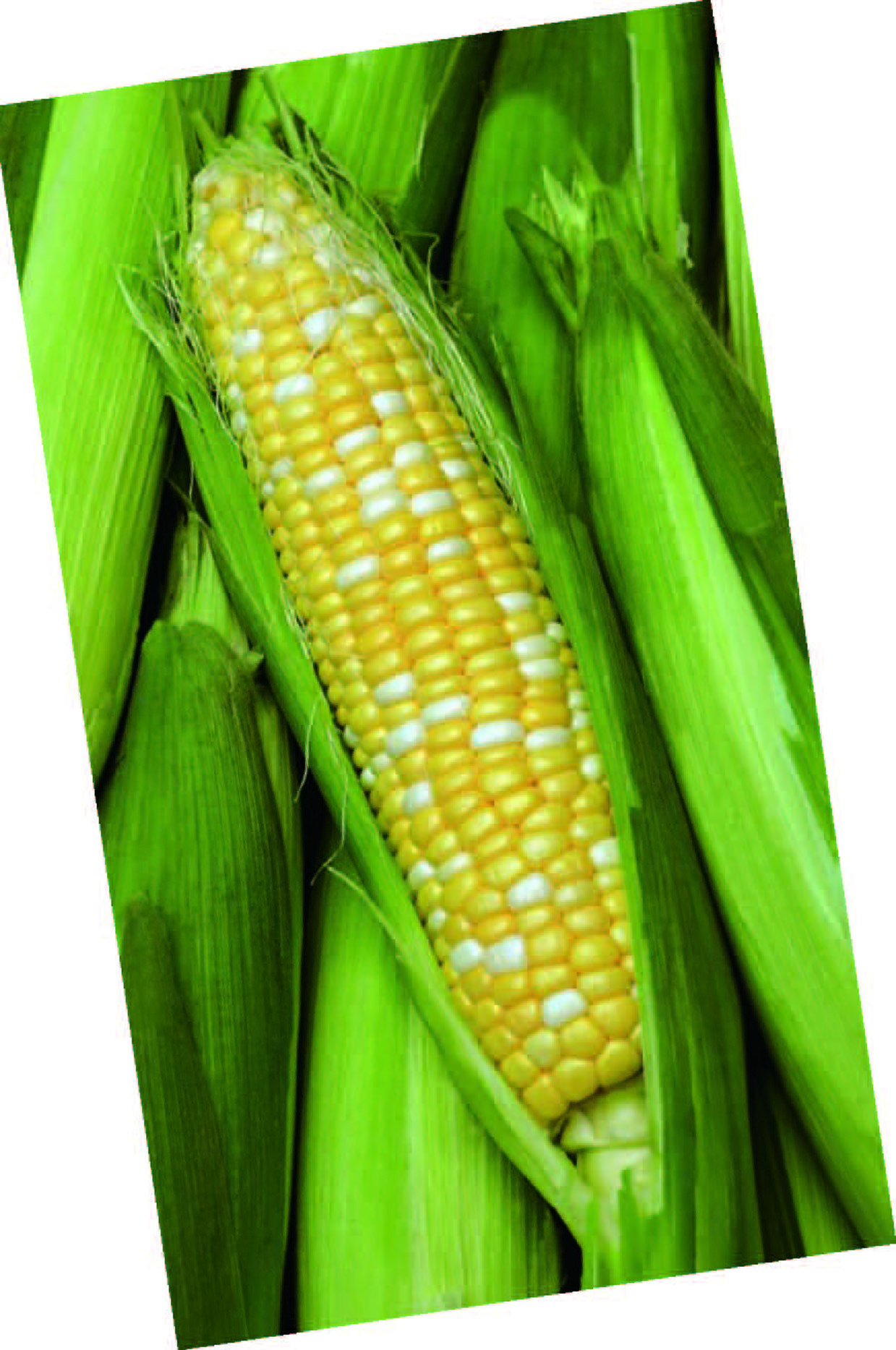
Fortunately, vitamin B3 is stable to heat, so you can cook up a storm. Even canned corn provides a portion of the benefits.
Corn chips and tacos have become a popular snack or meal maker, and even though they only provide a nutritional crunch on their own, added ingredients can make them a complete healthy meal. I have noticed children eating lettuce, grated carrot, capsicum, kidney beans and cheese when tacos are prepared, so they’re a great way to help children obtain proper nutrition. The fast and simple nachos is also a delight and the crispy tortilla can be full of flavour and natural ingredients. Corn bread is now available at supermarkets.
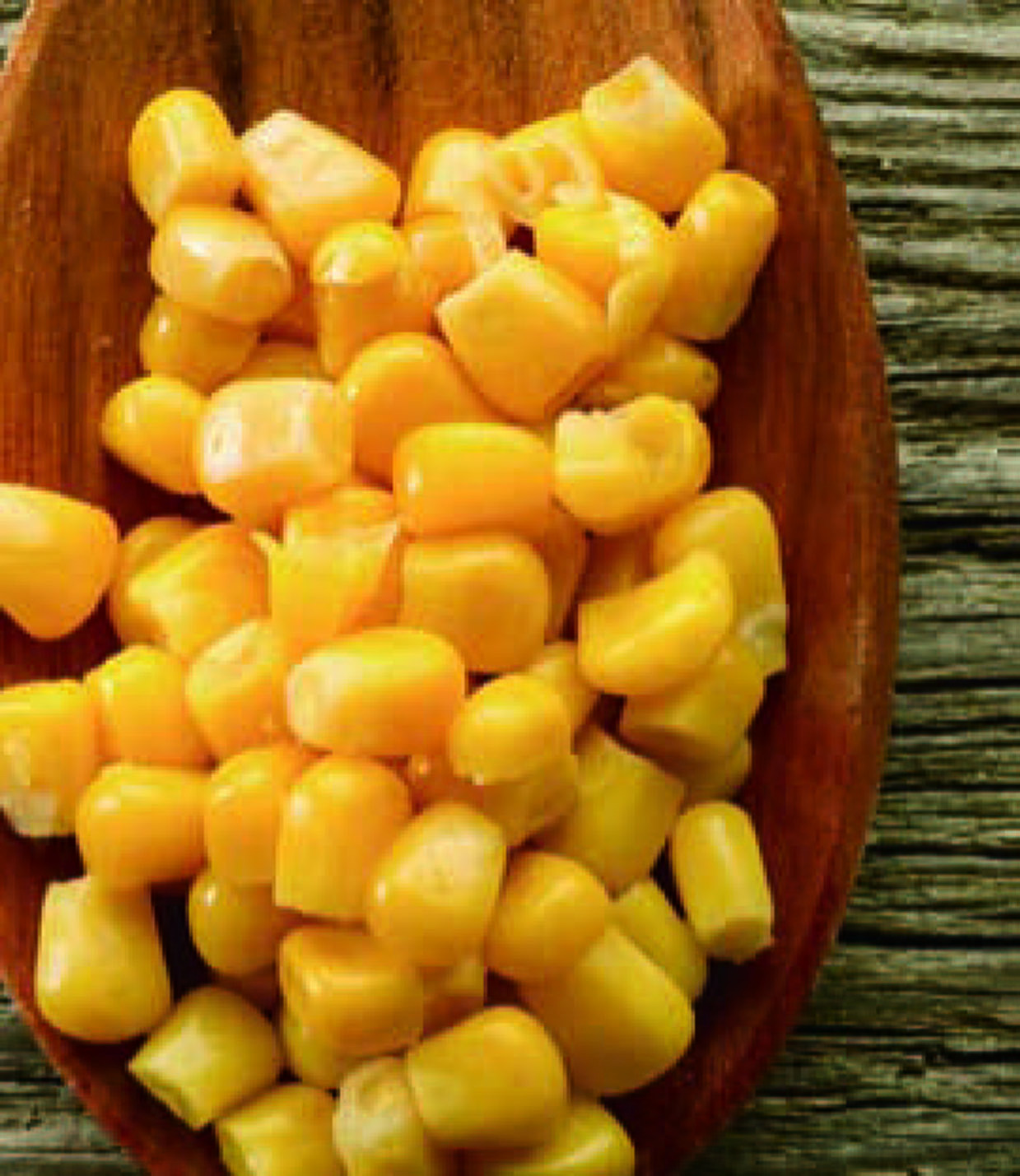
Try corn pancakes combined with steamed apples, a sprinkle of cracked almonds and a spoon of cream. ‘Corn-on’!
NOTE: All amounts in this book are measured in milligrams (mg) per 100 grams, unless stated otherwise.
| GLYCEMIC | C. P. L. | CALORIES – total: 378 kcal. per 100 grams |
| INDEX: 103 | 80 11 9 | Calories from: Carb: 300 Protein: 43 Fat: 35 |
MILLET – Eleusine coracana
Millet is, botanically speaking, a mixed bag of grains: finger millet, bullrush millet, common millet and foxtail millet. The main similar characteristics are the very small grains on a drought-resistant plant that can be grown in poor soils.
As half the world’s soils are depleted, millet may become more of a necessity in the future rather than simply enjoying its current status in the developed world as ‘bird food’ or cattle feed. Millet is cultivated on a large scale in the arid areas of India, Sri Lanka, Zimbabwe and other parts of Africa. Finger millet in particular can be stored for up to 5 years, a great famine reserve food in the dry tropics.
Millet has 4 times the amount of the essential mineral silicon (160mg) compared to wheat. Silicon is required for hair growth, blood circulation, protection from mental fatigue, arthritis and infection.
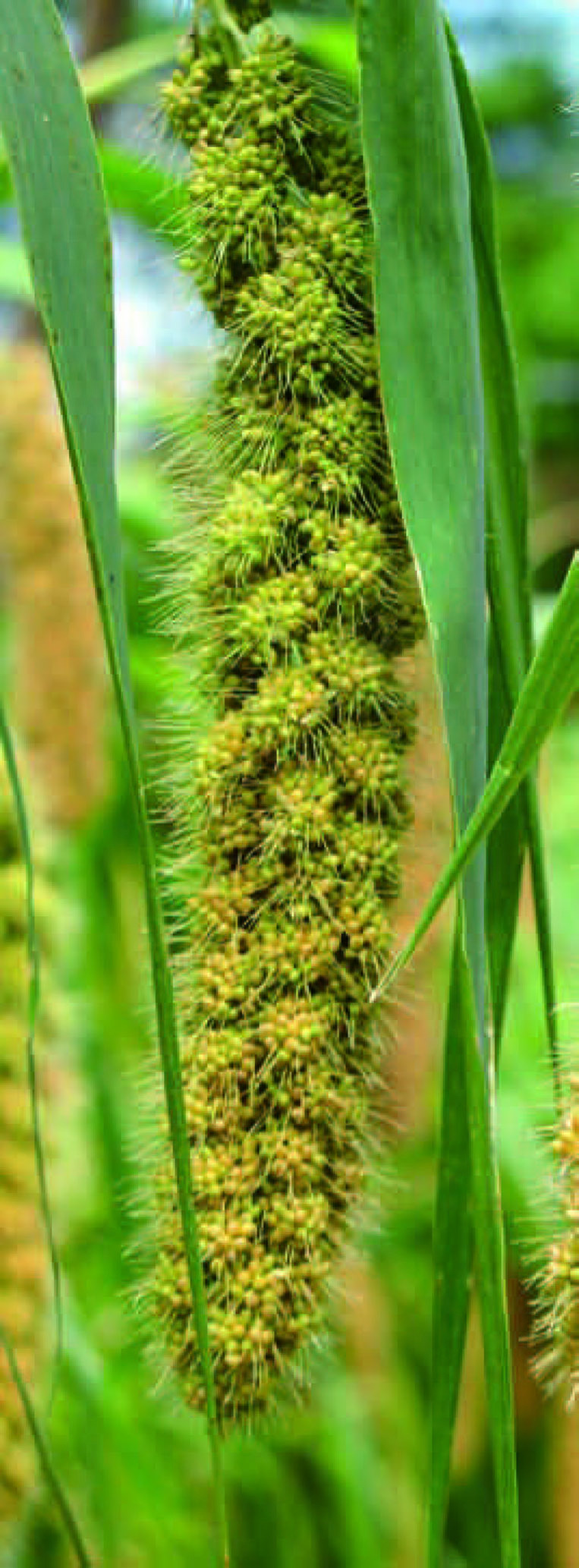
Millet provides over twice the iron content (3mg–6.8mg) of wholewheat and four times that of rice. Millet contains the same magnesium content (162mg) as wholewheat, twice that of rice and seven times that of white bread. Magnesium is known to reduce migraine attacks and the severity of asthma, plus it reduces high blood pressure and is vital for the nervous system, memory and strong bone development.
Millet will continue to have an expanding role in our future diet due to being gluten free. For people with wheat allergies, coeliac disease and other yeast intolerances, the millet grain can provide a breakfast meal that is low in fat (4.2g), high in fibre (8.5g or 34% d.v.) and provides complete protein (11g), with a great carbohydrate supply (72g).
The question is, how does it taste? Like any food, if it’s prepared properly and you’re hungry, it tastes magnificent. Rinse half a cup of millet in a sieve, place half a cup of millet, 1 cup of water and 1 cup of milk in a saucepan, simmer for 10–15 minutes while stirring. Add extra milk or water when required, as millet requires nearly 5 cups liquid per 1 cup serve. Add a dash of cinnamon and nutmeg, and serve in a bowl with stewed apples, slivered almonds and a dribble of sweetened cream—a breakfast that will beat any processed cereal nutritionally. Millet can take the place of rice with vegetable dishes or add it to muffins. Refer to section entitled as How Do I Obtain More Wholegrains In My Diet? for a few simple millet recipes. In India, millet is made into bread called roti and in Africa the daily bread injera. For a French-style recipe try Normandy millet, or grind millet and add it to a bread mixture.
Millet is also a good source of folate (85mcg—more than cooked broccoli). During pregnancy, the combination of the great iron and folate content makes millet a sensible food to use regularly, instead of toast. Millet also provides the mineral zinc (1.7mg) required for improved immune system function, reproductive system, good skin condition and general body healing. Millet provides copper (0.7mg or 37% d.v). That’s more than meat, oysters or bread.
Millet provides an abundance of phosphorus (285mg or 47% d.v.), essential for the nervous system, memory and energy distribution. Millet is the ideal gluten-free grain and substitute for wheat and bran. It is a non-allergenic food, so don’t get ‘stuck in a rut’ with wheat for breakfast, lunch or the evening meal—the minute millet grain is ready any minute!

NOTE: d.v. refers to the daily value for women 25–50 years, refer to RDI chart for adult male and child values.
| GLYCEMIC | C. P. L. | CALORIES – total: 389 kcal. per 100 grams |
| INDEX: 49 | 70 15 15 | Calories from: Carb: 273 Protein: 58 Fat: 58 |
OATS – Avena sativa
Oats have a short history compared to other grains. They were first cultivated about 3000 years ago in Europe. Oats must be prepared quickly after harvesting due to a fat-dissolving enzyme within the grain that causes spoilage. Only 5% of the oats produced are used for human consumption. The thoroughbred horses get the balance so no wonder they are winners!
Oats are now recognised as a great nutritional food. Scottish people have kept fit and strong for centuries with oats as a staple food. They even beat the Romans in battle. Oats are prepared into various forms such as oat groats which provide the wholegrain benefit. Quick cooking oats are pre-cooked and finely cut. Oat bran provides numerous health benefits. The ‘old-fashioned’ rolled oats are basically the whole grain that is steamed and flattened by rolling. Ideally, use the best quality rolled oats.
Oats for breakfast is a meal that can balance your daily energy levels. Oats contain a special ingredient in the fibre, known as beta glucan. It helps to slow the rise in blood sugar levels, ideal for diabetics. These days, with so many foods loaded with sugar, the use of oats is more a necessity than a choice. For children, the sugar cravings and lolly eating, plus soft drink consumption can eventually trigger the onset of diabetic symptoms: hyperactivity, inability to concentrate and a miserable attitude, to mention a few.

A bowl of well-prepared porridge for breakfast can really balance the body for an active day. Place 1 cup of quality whole rolled oats in a saucepan with 1 cup of water and 1 cup of milk. Slowly bring to a low simmer, while stirring regularly. Add extra milk to ensure a s mooth consistency. Add a splash of cinnamon, dash of salt and serve with stewed apples and sweetened cream. For adults, try raw rolled oats, soaked overnight or for at least 10 minutes in goat’s milk or ‘pure milk’. Where do you get ‘pure milk’? Well, you make it.
Find a top-quality plain acidophilus yoghurt made from raw milk—check the labels, as only a few are made from raw milk. Mix 3 tablespoons of the yoghurt in a jar with 1 cup of pure water, stir very well, shake and pour over the raw rolled oats. Add sliced peaches or canned apricots on top and serve with a dribble of sweetened cream. Now that’s the best balanced breakfast.
Apart from the stabilised blood sugar levels, the beta glucan in rolled oats can reduce blood cholesterol by 8–23% according to one study. Oats are the best grain source of complete protein (17g or 34% d.v.) and that’s from a small 100-gram serve, without the extra protein value when the milk is added. Just imagine if you added a few ground almonds or sunflower seeds—you’d be obtaining over half your daily protein requirements at breakfast.
Oats are also an excellent source of fibre (10.5g or 42% d.v.). For those concerned about colon cancer, fibre is vital. The rich supply of selenium from oats (35% d.v.) and oat bran (45mcg or 55% d.v.) has an important role with glutathione peroxidase in promoting antioxidant power and a decreased risk of bowel cancer. (White bread, meat and chicken are all common foods with one common negative factor: they provide no fibre.)
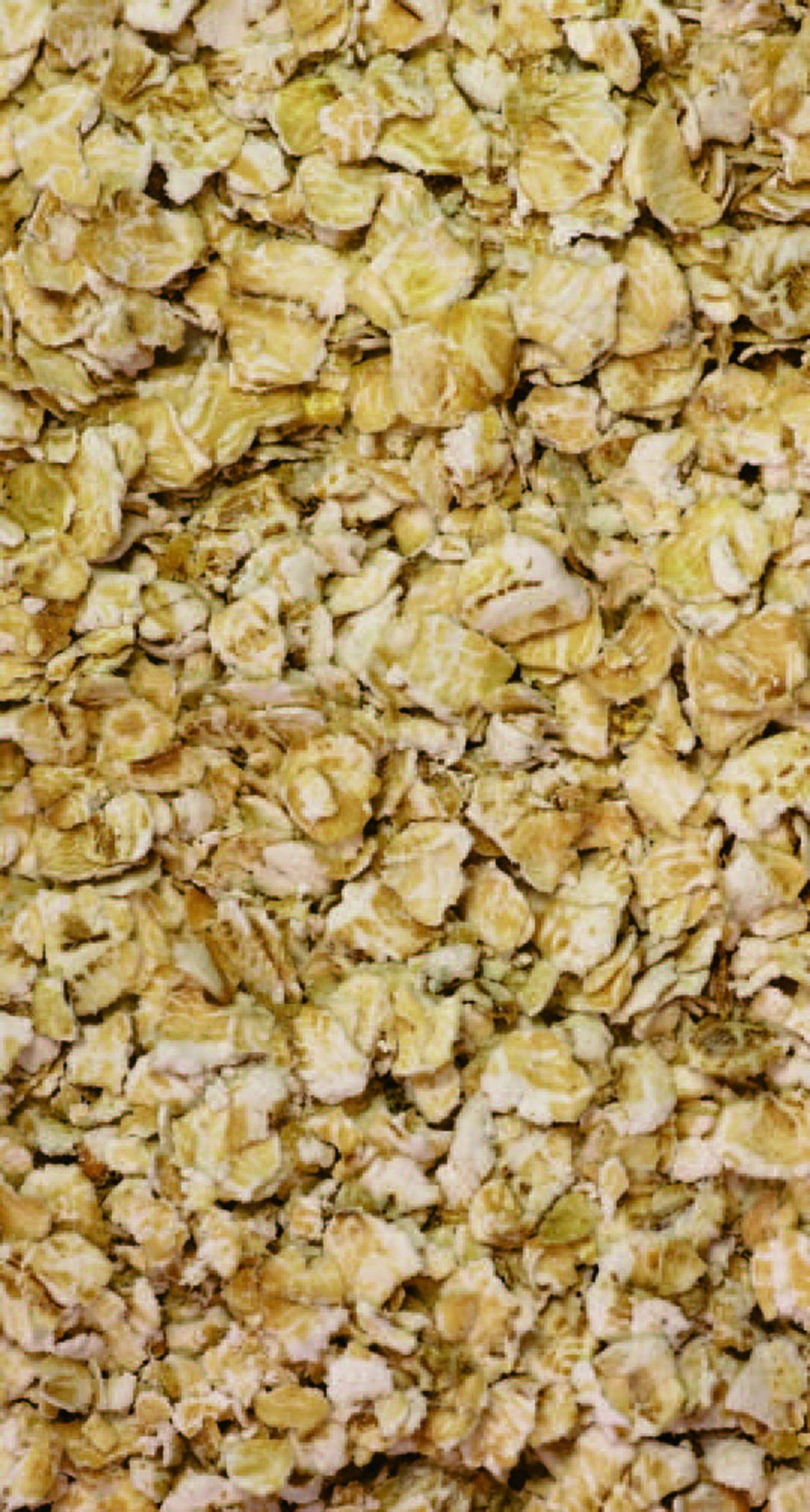
There’s an old Scottish proverb: ‘The whiter the bread, the sooner you’re dead.’ Don’t delay, get your oats today!
NOTE: All amounts in this book are measured in milligrams (mg) per 100 grams, unless stated otherwise.
| GLYCEMIC | C. P. L. | CALORIES – total: 340 kcal. per 100 grams |
| INDEX: 56 | 76 11 13 | Calories from: Carb: 257 Protein: 39 Fat: 44 |
OATS (MUESLI)
Oats are the main ingredient in muesli, a recipe invented by Dr Bircher-Benner of Switzerland in the late 1900s. The name ‘muesli’ translates to mean ‘mixture’. Dr Bircher-Benner developed a sanatorium for healing and the muesli recipe was designed specifically as a complete health-restoring meal.
The original recipe was prepared on a daily basis and it was given to the patients throughout the day or night. Initially, the method included rolled oats being soaked in pure milk overnight. Later on the recipe changed and freshly extracted fruit juice replaced the milk. In the morning, raw hazelnut or almond pieces plus an abundance of grated apple, a few grapes and berries were added.
The original muesli recipe can be refrigerated for up to 2 days and contains no sugar. Processed muesli formulas are often toasted and have too many ingredients in poor combinations, causing poor digestion.
Oats are the greatest ‘brain grain’, the abundance of inositol (12mg), a B complex vitamin, is vital for nourishment of brain cells as it assists in the transfer of neurotransmitters between brain cells. Inositol can be manufactured by the body from glucose, and with oats, the great supply of carbohydrates (66g or 22% d.v.) is converted into glucose. This provides a stable supply of brain energy; in fact, the brain utilises up to 90% of all glucose, the remainder is used by muscles during activity. The excellent supply of magnesium (177mg or 44% d.v.) adds weight to the ‘brain grain’ title of oats. This mineral is not only required for conversion of carbohydrates into glucose but is also vital for a good memory, as it activates brain activity and nourishes the white nerve fibres of the brain.

Oats are also an excellent source of phosphorus (523mg or 52% d.v.) A lack of phosphorus can lead to poor memory and poor concentration. Processed breakfast cereals are low in phosphorus, plus sugar causes a depletion of this vital mineral.
Oats are an excellent source of manganese (4.9mg or 100% d.v.), ‘the memory mineral’. Manganese also helps stabilise glucose levels; it is very important for people with diabetes. Manganese is essential for brain function as it coordinates nerve impulses plus it is a natural antioxidant and essential for the reproductive system. The ample supply of copper (0.6mg or 31% d.v.) assists the nervous system. Copper is likely to be the missing mineral causing post-natal depression. Serum copper levels rise considerably during pregnancy due to elevated oestrogen levels which can take months to stabilise. The bonus with oats is that the copper is balanced with the mineral zinc (4mg or 26% d.v.), as they both compete for absorption within the digestive tract.
The good iron content (4.7mg or 26% d.v.) is vital, especially during menstruation, pregnancy and after childbirth. For maximum benefits, add strawberries on top of the muesli breakfast, as the added vitamin C plus good protein from oats (17g) will greatly assist absorption of the iron. The vitamin B1 (0.8mg or 51% d.v.) supply is very good and promotes mental efficiency and nerve cell function. Oats provide B5 (1.3mg), folate (56mcg) and B6 (0.1mg). The potassium content (429mg) assists muscle and nerve function. The fat content of oats is (7g), providing the wonderful creamy texture.
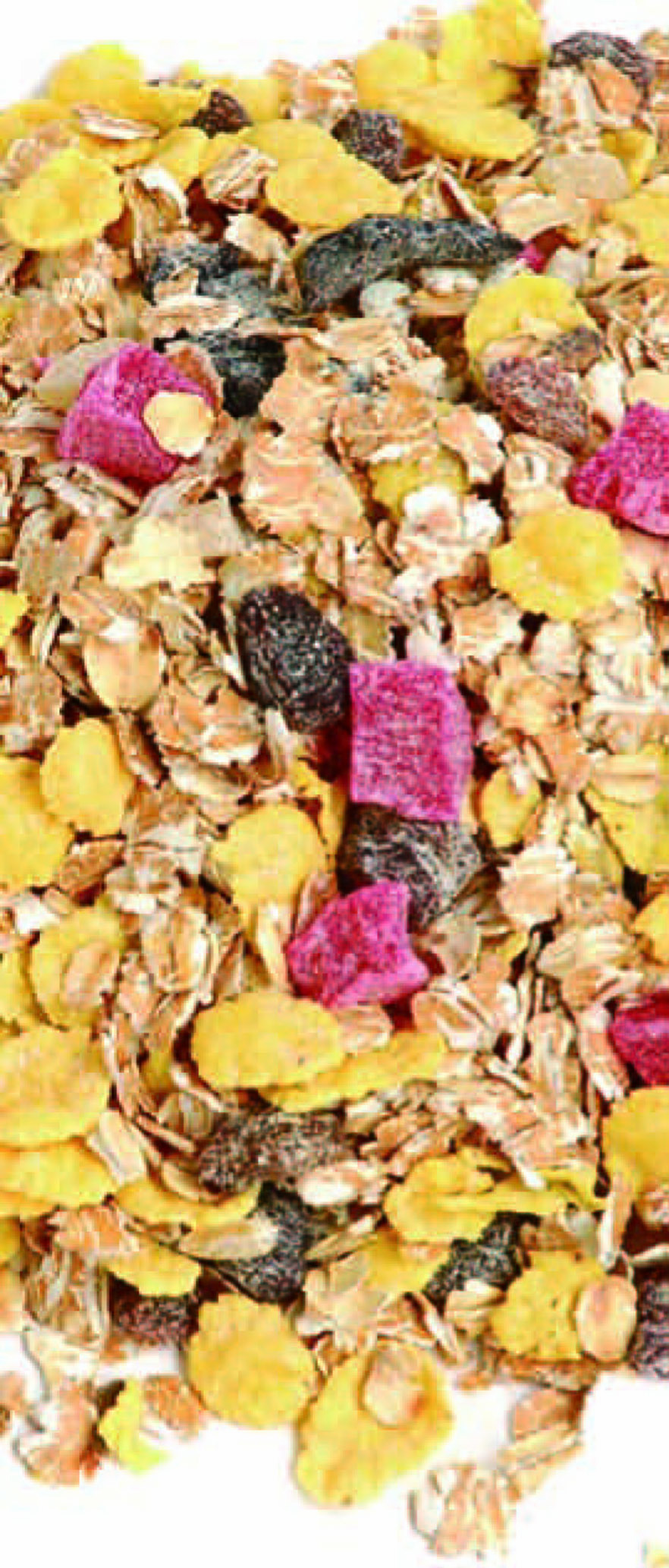
Muesli is ready to make your day original!
NOTE: d.v. refers to the daily value for women 25–50 years, refer to RDI chart for adult male and child values.
| GLYCEMIC | C. P. L. | CALORIES – total: 365 kcal. per 100 grams |
| INDEX: 72 | 91 7 2 | Calories from: Carb: 332 Protein: 27 Fat: 6 |
RICE (WHITE) – Oryza sativa
Rice feeds half the world’s population. It was first cultivated in China over 6000 years ago. Rice is the only underwater grain and initially planting and harvesting were by hand and with water buffalo. This method is still in use in some cultures today.
Whole rice can be stored for up to 6 months, unless it is processed into white rice. The outer layers of whole rice contain the rice bran and oil-rich germ layer, which are susceptible to oxidation and rancidity. There are three main types of rice: long grain, medium and short grain. They can all be eaten as either whole brown rice, or refined into white rice.
Nutritionally speaking, there is a vast difference between brown and white rice with approx.60% loss of nearly all nutrients in white rice. White rice needs added vitamins to be approved for sale. Enriched rice has added B vitamins and iron; however, over 10 other nutrients that are ‘milled out’ are not replaced.
White, polished rice is basically pure granules of starch. During the Spanish colonial wars, the British soldiers were fed white rice, while their servants lived off the rice water from cooking. The soldiers developed beriberi, a vitamin B1 deficiency. The servants worked harder but did not develop beriberi.
Fortunately, white rice is usually served as a base ingredient for numerous dishes where a variety of other ingredients can supply nutrients, thereby reducing the risk of problems.
However, in some places, where rice makes up nearly 90% of the daily diet, white rice is barely enough to maintain life and the added nutritional benefits of the wholegrain brown rice can really be a deciding factor for health.
Rice was behind the initial discovery of B vitamins. Dr Eijkman, in 1897, proved that men who ate wholegrain rice did not contract beriberi. The Japanese navy lost thousands of sailors following the regular daily use of polished or white rice. Dr R.R. Williams, first extracted vitamin B1 from the rice bran. His comment after receiving an award was, ‘Man commits a crime against nature when he eats the starch and throws away the mechanism necessary for the metabolism of that starch.’

Apart from the B1 deficiency in white rice, the loss of major minerals and other vitamins is obvious (refer to chart) and white rice cannot be considered a nutritious food. But if that’s the only way the children will eat rice, be sure to use enriched rice, pile on the carrots, peas, corn, beans or cheese, and make a peanut sauce. Or add a dash of vegemite or rice bran, because B1 is vital for children’s growth, memory, concentration and appetite. A prolonged deficiency of B1 can also lead to irritability and depression
Basically, white rice and white bread are the classic ‘empty calorie’ foods. They do not provide the essential nutrients to support the proper digestion and absorption of their own starch content in particular. For example, B1 is essential for proper digestion/absorption of starch, B2 essential for secretion of gastric juices and absorption of carbohydrates, B3 assists the function of many digestive enzymes, B5 is required for enzyme development for carbohydrate utilisation, manganese for digestive and enzyme reactions, phosphorus for energy distribution, and iron for protein metabolism. All the essential fatty acids or vitamin F plus fibre are lacking from white rice. White rice is nice and filling but nasty in its lack of ability to give back nutrition.
|
Except for calories and protein (g): all amounts are measured in mg per 100 grams, dry weight approx.* added nutrients |
BROWN RICE |
WHITE RICE |
WHITE ENRICHED |
RICE BRAN |
FLOUR BROWN |
WILD RICE |
|---|---|---|---|---|---|---|
| CALORIES | 359 | 357 | 363 | 276 | 292 | 353 |
| PROTEIN | 7.5 | 6.5 | 6.7 | 13 | 5.6 | 14 |
| CALCIUM | 32 | 17 | 8.7 | 76 | 8.6 | 19 |
| PHOSPHORUS | 256 | 111 | 108 | 1,386 | 271 | 432 |
| POTASSIUM | 259 | 110 | 86 | 1,495 | 233 | 426 |
| IRON | 1.6 | 0.7 | *4.3 | 19 | 1.5 | 1.,9 |
| VITAMIN B1 | 0.34 | 0.08 | *0.5 | 2.3 | 0.35 | 0.11 |
| VITAMIN B2 | 0.05 | 0.03 | *0.04 | 0.25 | O.O6 | 0.02 |
| VITAMIN B3 | 4.6 | 1.6 | *5 | 30 | 5.1 | 6.1 |
NOTE: All amounts in this book are measured in milligrams (mg) per 100 grams, unless stated otherwise.
| GLYCEMIC | C. P. L. | CALORIES – total: 370 kcal. per 100 grams |
| INDEX: 55 | 86 7 7 | Calories from: Carb: 318 Protein: 27 Fat: 25 |
RICE (BROWN) – Oryza sativa
Wholegrain brown rice is full of remarkable benefits and the alkaline balance it provides after digestion is a real bonus for health. Nearly all foods, except almonds, fruits, vegetables, soy and millet, are classed as acid-forming foods. The ideal diet needs 75% alkaline-forming foods. Brown rice is a miracle worker in health-restoring benefits due to this one factor alone. Use a rice cooker or steamer to gain a soft texture—it only takes 15 minutes longer to cook than most white rice.
Brown rice provides complete protein (8g), and compared to all grains, it has the best percentage of available protein (70% n.p.u.). When such foods as cheese or milk are added, the protein value increases another 30%, and with legumes the increase is 40%. One bowl with 200g of cooked brown rice with a serve of kidney beans topped with cheese will provide over half the adult daily protein requirements, plus at one quarter the price of beef. Brown rice provides 140% more fibre than white rice and nearly 3 times the iron content (1.5mg). The manganese content (3.7mg) of brown rice will provide over 50% of the daily requirement (2–5mg). It is essential for the nerves, hormone production and as a component of an antioxidant enzyme termed superoxide dismutase; required to protect against free radicals that are produced during the production of energy from cells. Brown rice is a good source of selenium (23mcg), which has an RDI of 70–85mcg and is required for protection from heart disease and free radicals.

The phosphorus content (333mg or 33% d.v.) is beneficial for blood circulation, the nervous system, brain and skin system. But processing destroys over half the value of this vital mineral. The magnesium content (143mg or 36% d.v.) is over 4 times that of white rice; no wonder stress is booming, as magnesium is essential for relaxed nerves, plus alcohol depletes magnesium.
Brown rice is one of the easiest foods to digest (in 2 hours). It actually takes less time to digest than white rice (2 hours 30 minutes). If you are looking for a power-packed powder, try a sprinkle of rice bran on your white rice dish, or in the sauce or gravy and retrieve the abundance of missing nutrients. Rice bran provides nearly 8 times the B vitamin content of brown rice and 40 times that of white rice. Rice bran is potent in phosphorus (1386 mg), iron (19mg), silicon (885mg) and potassium (1495mg)—now that’s nutrition. Rice bran needs to be kept in the fridge to maintain its benefits. Try a sprinkle in sauces, breads, cookies, pancakes or on the basic breakfast cereal, and whenever you have the ‘nice white rice’, a dash of rice bran can provide a great balance to all that soft white starch.
Another rice, called wild rice (Zizania aquatica), is more expensive but prized in the best restaurants and home kitchen. The protein (14g) is double that of brown rice but with a similar carbohydrate value (75g). Most nutrients are present in approx.20% greater value except for calcium (19mg). It’s a good source of iron (4.2mg) with a similar calorie value (353).
It’s good to note that all rices are gluten free, ideal for those with coeliac disease, yeast infections and wheat intolerances. Ideally, let brown rice replace numerous other wheat or meat meals to gain alkaline body and blood balance. If you have to take away, it’s better to have rice than a hamburger. The price of brown rice is another major benefit. Yes, brown rice is all right tonight!
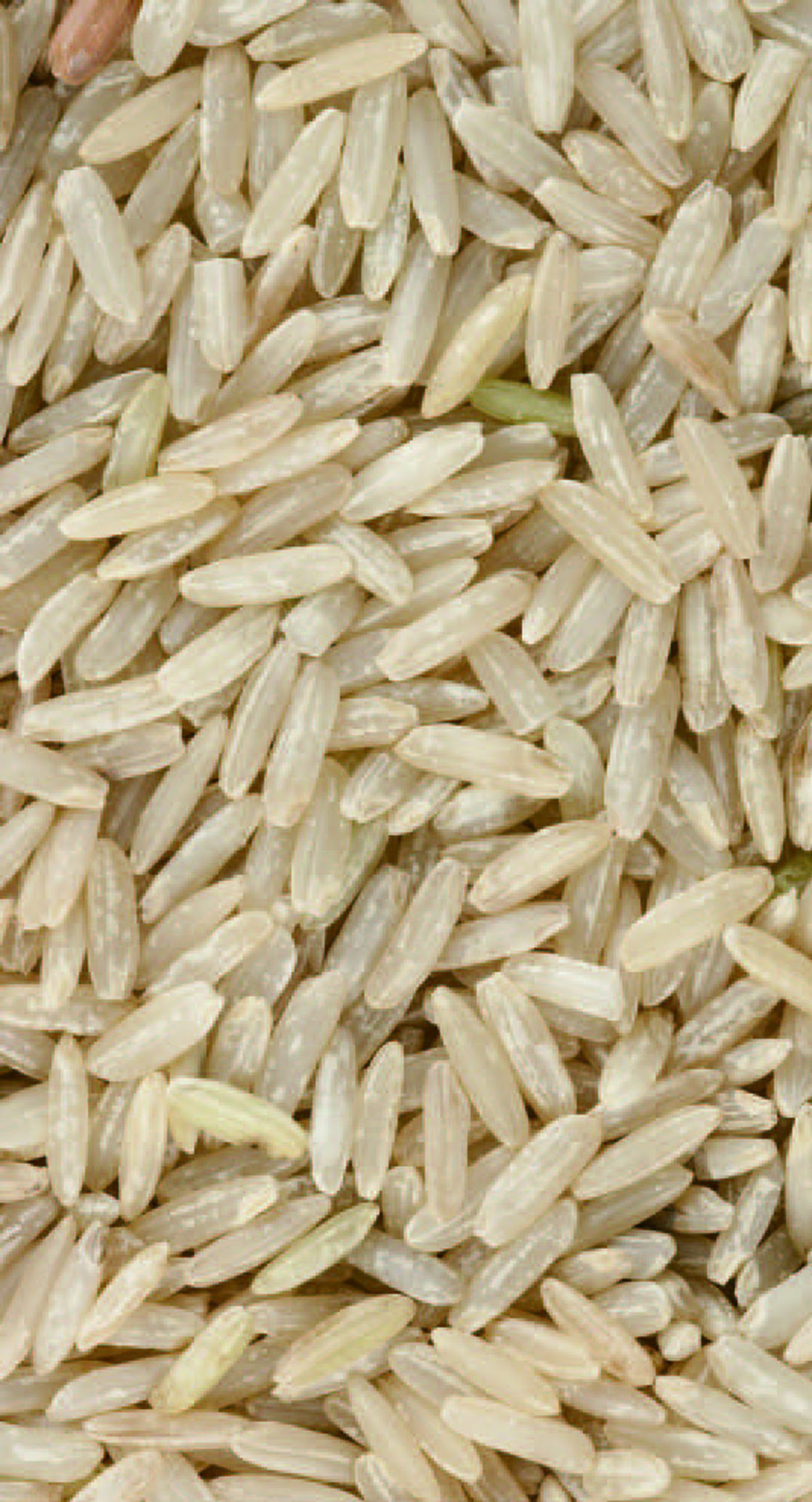
NOTE: d.v. refers to the daily value for women 25–50 years, refer to RDI chart for adult male and child values.
| GLYCEMIC | C. P. L. | CALORIES – total: 335 kcal. per 100 grams |
| INDEX: 76 | 81 13 6 | Calories from: Carb: 269 Protein: 45 Fat: 21 |
RYE – Secale cereal
Rye is a grain that can withstand cold, acid soil and low rainfall. Rye has been a staple grain in Europe, Scandinavia and Russia for centuries and it was first cultivated by the Romans during 400 BC. Rye also had a dark history due to a fungus, ergot, that attacked the grains producing a virus in humans and animals. During the Middle Ages, and even up until 1953 in France, the virus caused severe conditions with the central nervous system. Modern science has eliminated this disease in the rye plant. Remember, the potato also caused problems back in the ‘hay days’, so don’t be put off this natural wholegrain.
Today, rye is gaining popularity as a replacement for wheat bread and it is also used to make whisky. Wholegrain rye is referred to as rye groats and they are best pre-soaked prior to cooking or steaming like rice and added to soups, bread or stews. The protein content (14.8g or 30% d.v.) of whole rye is a great benefit; it provides complete protein with a low fat content (2.5g or 4% d.v.). A vegetable soup with rye groats sounds unappetising, but once the rye has been soaked overnight and simmered in vegetable stock for 1 hour then cooked with winter vegetables and spices for 30 minutes, before serving with a splash of cream, the ‘rye soup’ is on the way to being a delicious provider of flavour and nourishment.

Rye bread is available in numerous varieties and the common factor is the low gluten content compared to wheat. However, some rye breads also include either wheat flour or added gluten, to give the bread a soft and lighter texture. The ultimate rye bread is made with organic rye flour, sour rye dough, water and no yeast. Another benefit of rye bread is the excellent fibre content (14g or 55% d.v.), as the bran and germ content are difficult to separate from the grain during milling compared to wheat. The fibre content will help protect against colon cancer, as fibre binds with toxins in the colon to regularly eliminate possible cancer-causing substances. Rye is the second-best grain source of the mineral phosphorus (374mg or 37% d.v.) and when you add a slice of cheese on the rye bread, the benefits for the bones, skeletal system and nervous system are excellent.
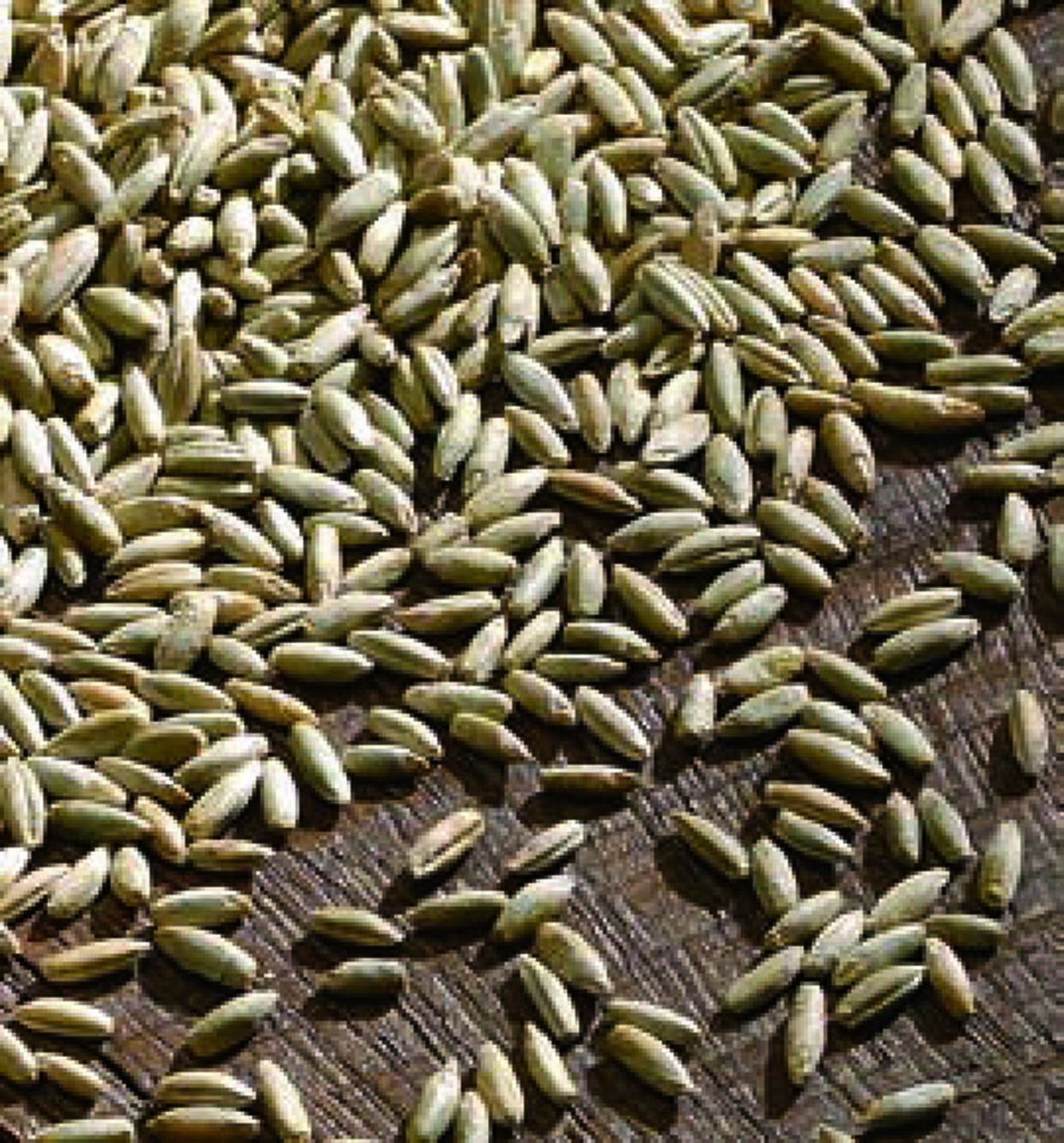
Rye is also a source of lingan, a natural oestrogen that can be very beneficial during menopause to stabilise the natural oestrogen levels. During menopause, normal oestrogen levels can diminish causing discomfort and hot flushes. Lignan can also inhibit excess oestrogen production, a possible cause of breast cancer, as it blocks the oestrogen receptors. In addition, the supply of manganese (2.7mg or approx.50% d.v.) is vital for regulation of menstrual cycles and normal blood sugar levels. The good supply of magnesium (121mg or 30% d.v.) plus the valuable supply of zinc (3.7mg or 25% d.v.) and phosphorus all add up to make the rye grain ideal for strong bone development. Rye bread is full of selenium (35mcg or 30% d.v.) and that promotes the function of the thyroid gland in regulating metabolism. White bread contains none of the above benefits nor any of the following nutrients found in rye bread: vitamin E (1.3mg), folate (60mcg), potassium (264mg). As an added bonus, rye bread has a wonderful rich flavour. So shop around for the best rye bread and enjoy the benefits. Rye, Rye for now!
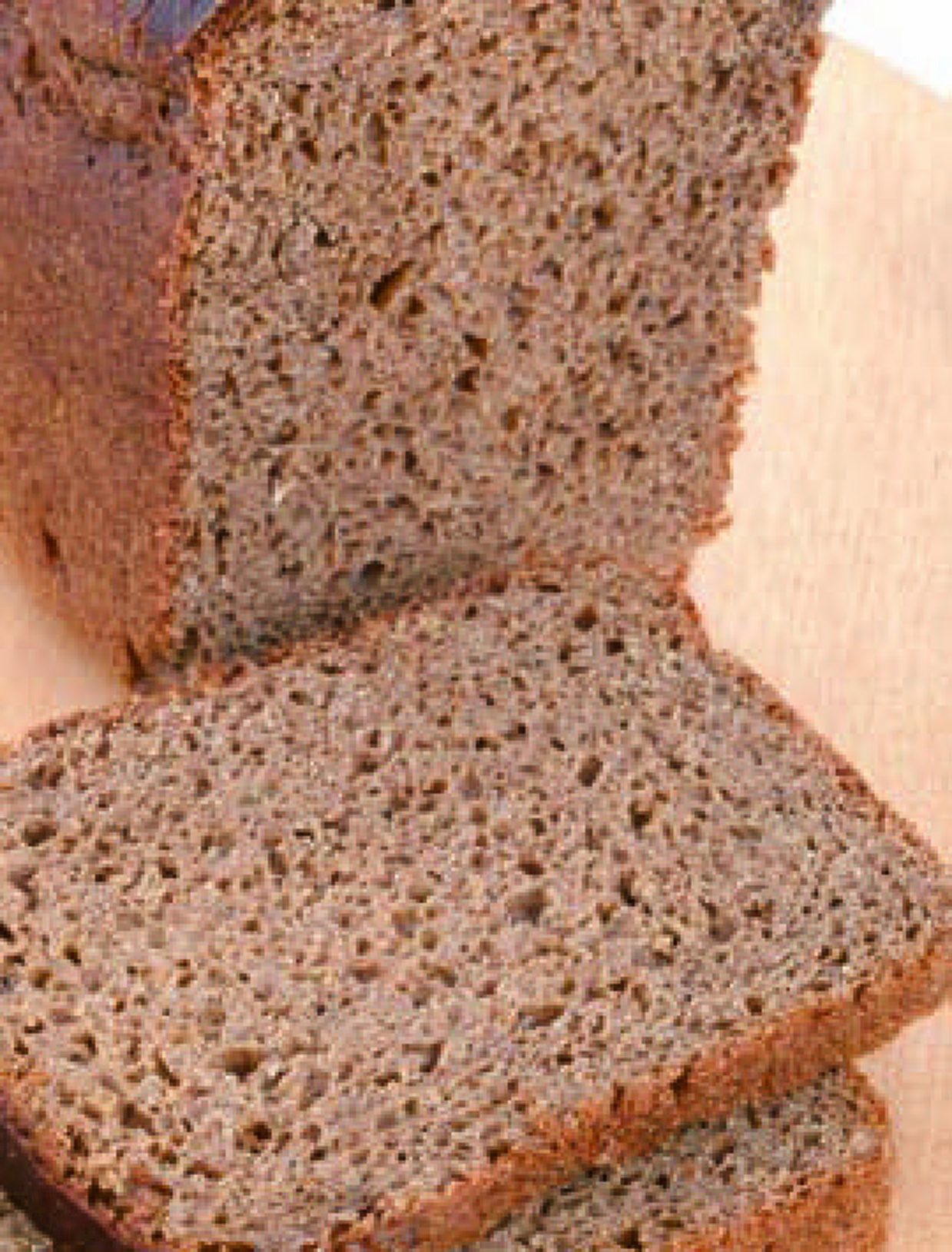
NOTE: All amounts in this book are measured in milligrams (mg) per 100 grams, unless stated otherwise.
| GLYCEMIC | C. P. L. | CALORIES – total: 329 kcal. per 100 grams |
| INDEX: 67 | 82 13 5 | Calories from: Carb: 258 Protein: 55 Fat: 16 |
WHEAT – Triticum
Wheat cultivation has spread around the world with varieties that are grown in nearly all climates, from Arctic to subtropical. There are two main types of wholewheat: hard wheat and soft wheat. However, there are thousands of varieties of wheat, of which about 300 are used commercially. Among the most common varieties is the hard red winter wheat, which originated in Canada and is now used worldwide. It is ideal for breadmaking, grows quickly and may be harvested three months after sowing. The next common variety is white wheat. It is ideal for pastry making and for breakfast cereals, as it is starchy and contains less gluten protein. Durum wheat produces the world’s best pasta; it is a very hard grain with an amber colour, and grows mainly in warm–dry climates. In England, the Mavis Dove wheat variety is most popular; it is a soft wheat, high in protein and classed as a winter wheat.
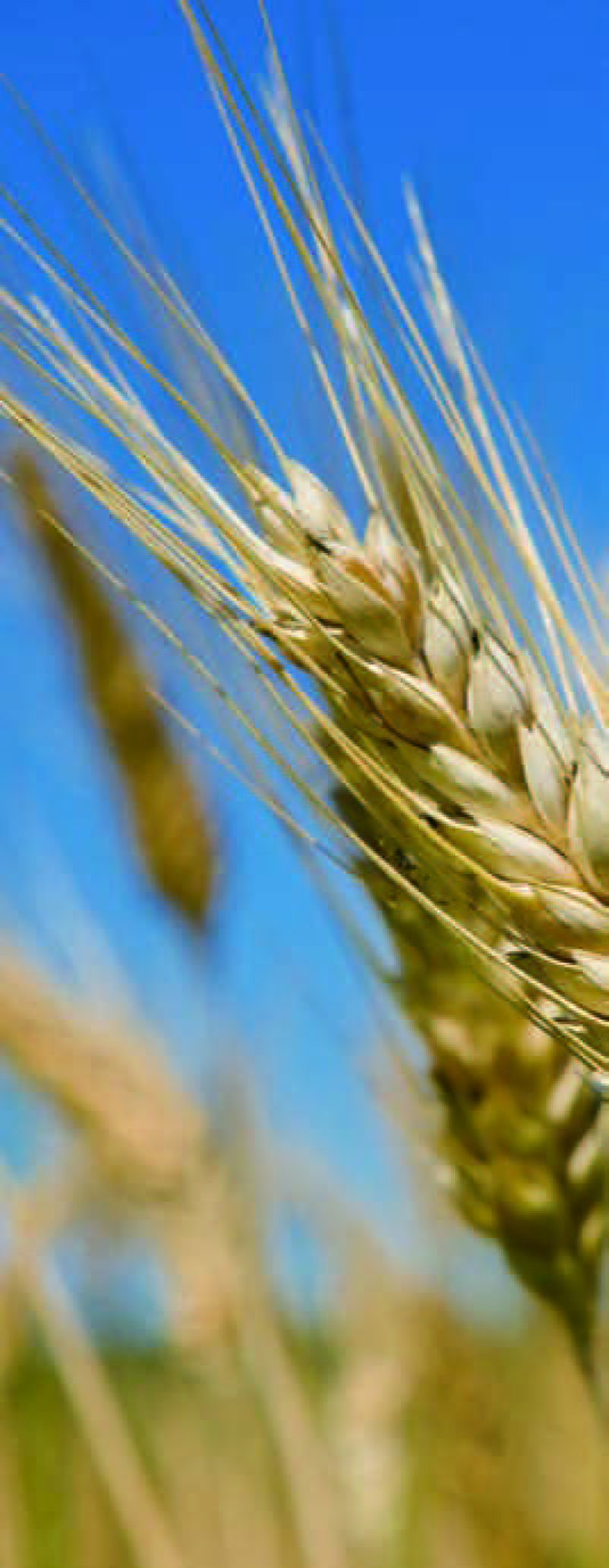
The wholewheat grain can be prepared in an incredible variety of recipes, products and forms. To gain the ultimate benefit from the wheat grain, there is nothing better than wheatgrass juice (refer to section entitled as Wheatgrass juice & sprouts). The second-best form of the wheat grain is the sprouted wheat. Used fresh on salads or mixed in a marvellous mayonnaise, they are delightful and highly nutritious. They can also be added to breads and soups, but fresh is best.
Apart from these methods, wheat is also prepared into various forms such as cracked wheat, used in the famous and healthful tabouli recipe and numerous soups. It is made from wholewheat grain, cracked under pressure and it provides the full grain benefits. Kibbled wheat is similar: it is produced from the wholewheat grain, placed through a ‘kibbler’ machine that cracks the grain into tiny pieces. These are used in breadmaking and some breakfast cereals.
The most common use of wheat is as flour.
The best quality flour is made from organic wholegrain wheat that is stoneground into a flour that contains the full value of the wheat grain, including the germ and bran content. Stoneground mills do not produce excess heat and therefore the flour is of better quality. Common milling uses steel rollers that move quickly, causing the wholegrain flour to heat, and the wheat germ content may turn rancid if not used promptly. Wholegrain flour does retain the entire wheat germ and bran layer, plus the starchy endosperm (the inner portion of the wheat grain). It needs to be used soon after milling.
Wholemeal bread varieties can vary considerably in their content, plus they may contain all the additives that are used in the production of white bread. Check the labels carefully until you find a loaf with life.
Commercial bread, even the top-quality stoneground, wholewheat bread, may contain a few additives to improve shelf life, but the fewer added, the better.
Due to the fact that the oil content in the wheat germ clogs up the steel mills, it is removed for better productivity. Wheat germ is then sold separately. It is the most nutritious part of the wheat grain, but must be kept fresh in a cool and airtight container and used within a few weeks. The wheat bran is also removed from the wholewheat grain in the production of white flour, as it makes bread bulky. White flour is the biggest business, used in bread that comes in hundreds of different shapes and sizes as well as in other recipes
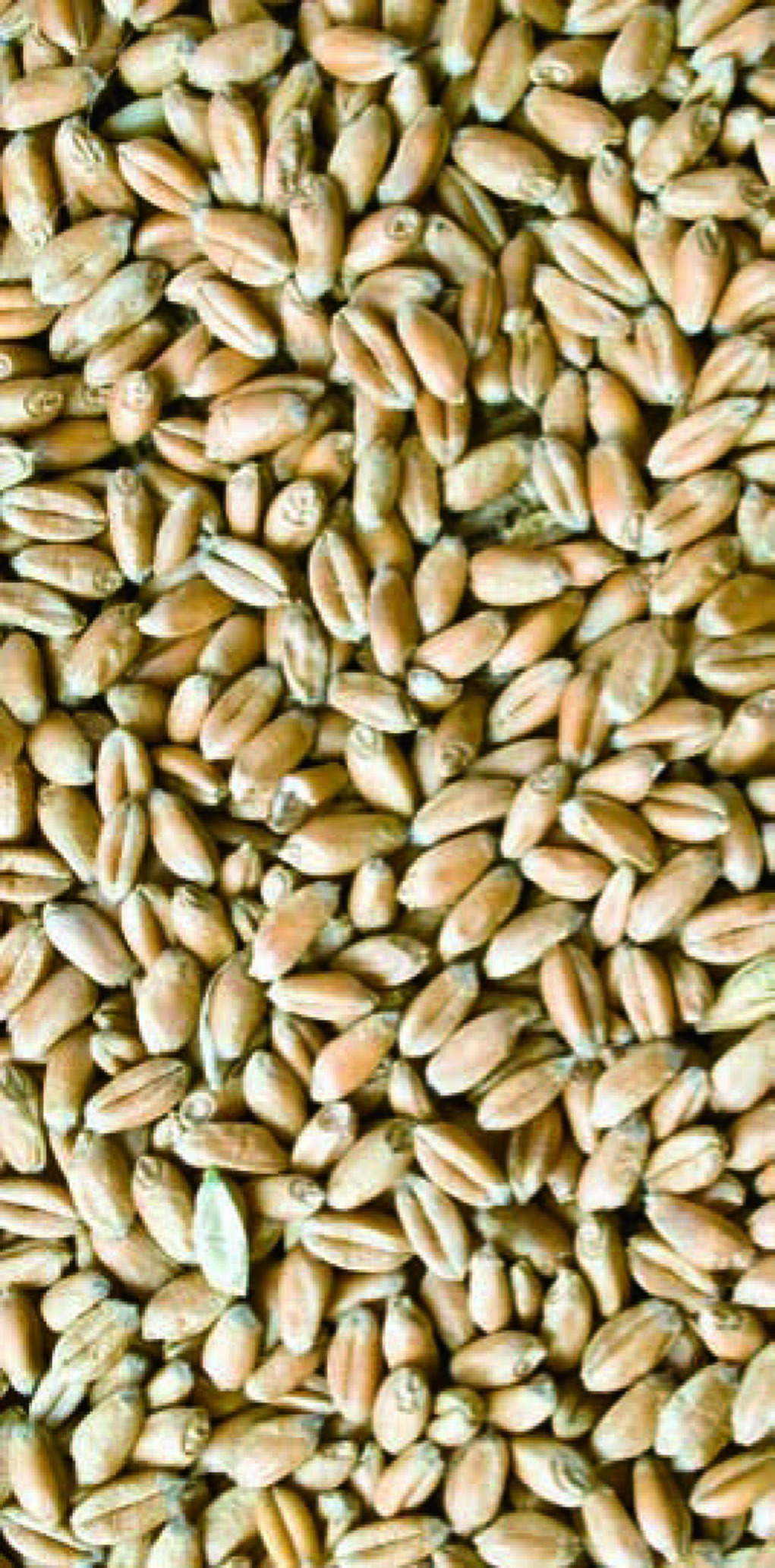
NOTE: d.v. refers to the daily value for women 25–50 years, refer to RDI chart for adult male and child values.
| GLYCEMIC | C. P. L. | CALORIES – total: 339kcal. per 100 grams |
| INDEX: 70 | 80 15 5 | Calories from: Carb: 274 Protein: 49 Fat: 16 |
WHEAT (BREAD)
For 10,000 years the wheat grain has provided the ‘staff of life’, the ‘daily bread’, and it was usually obtained in the wholegrain form. The current milling of wheat produces incredibly fine white flour and wheat products. The common milling process removes all the wheatgerm and bran content plus at least 40% (and up to 60%) of all nutrients, depending on the refinement grade of the wheat flour. Government health authorities now require ‘enrichment’ of flour for mass-produced bread; however, that returns only a small portion of a few B vitamins. When comparing the nutritional value of the wholewheat grain to refined flour and white bread, it is obvious that ‘humans cannot live by bread alone’ (refer to the chart in section entitled as Wheat (Flour Nutrients)).
The nutritional value of wholegrain wheat flour may be lowered by the presence of phytic acid in the bran. An excess intake of bran or wholegrain products may cause problems, as phytic acid combines with minerals—especially calcium, iron and zinc—forming insoluble mineral compounds that are not easily absorbed. The supply of calcium (32–100mg) in whole wheat may therefore be of no value, but the body can adapt to the phytic acid. For people who eat wholegrain breads as a staple food, it is more than likely their digestive system has overcome this problem. For people who are used to eating white bread, however, it may take a few weeks to adjust to wholegrain bread and the proper absorption of calcium, iron and zinc.
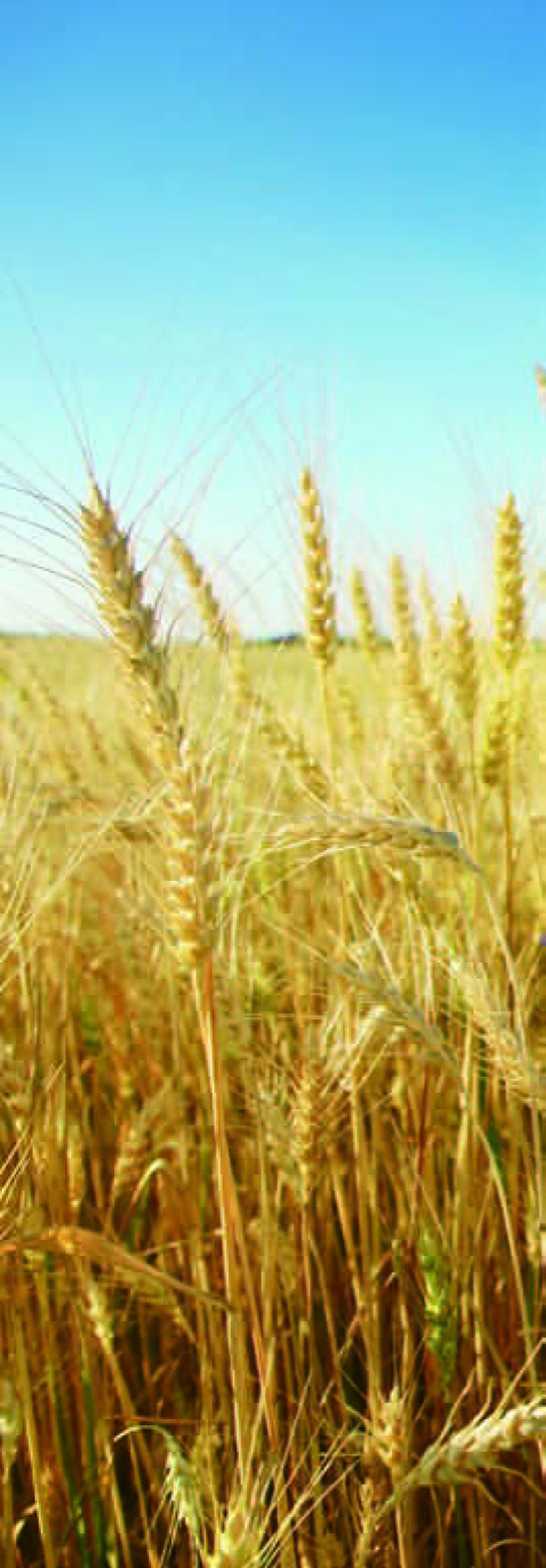
However, wholewheat and especially white bread are a poor source of calcium (3–8 % d.v.), so it is best not to ‘live on bread alone’. A Cheddar cheese sandwich will be full of calcium (728mg), while pasta with cheese or tahini (420mg) on bread will all provide great portions of the daily calcium requirements of 500–1300mg per day.
In regards to the fair iron content (2.5mg in both white and wholemeal bread; 3–4.6mg or 10–25% d.v. in wholegrain wheat), iron may bind with phytic acid in wholegrain bread which can reduce iron absorption if your digestive system is not used to wholegrain bread. Foods such as parsley (6mg of iron), pepitas (11mg), tahini (9mg), almonds (4.7mg), cashews (3.7mg), sunflower seeds (7mg) and dried apricots (4.4mg), when obtained regularly, will help provide this mineral, as the daily iron requirement is 8–18mg, and during pregnancy 27mg. Foods such as beef (1.7mg) and eggs (2mg), only add a little to the daily iron requirement. Five slices of white bread will provide approx.3mg of iron. With 5 slices of wholemeal bread approx.4.5mg of iron is provided, but it may not be absorbed unless it is regularly part of the diet. In regards to zinc, white bread provides 0.68mg, wholegrain bread 1.8mg, and the daily adult zinc requirement is 10–15mg.
The carbohydrate content of white bread (72.5g) and wholegrain bread (72.6g) is nearly identical. The same applies to protein: white has 12g and wholegrain 13.7g. The main difference is the fibre content: white bread 2.4g and wholegrain 12.2g or 50% d.v.. So wholegrain bread has nearly 5 times the fibre content!
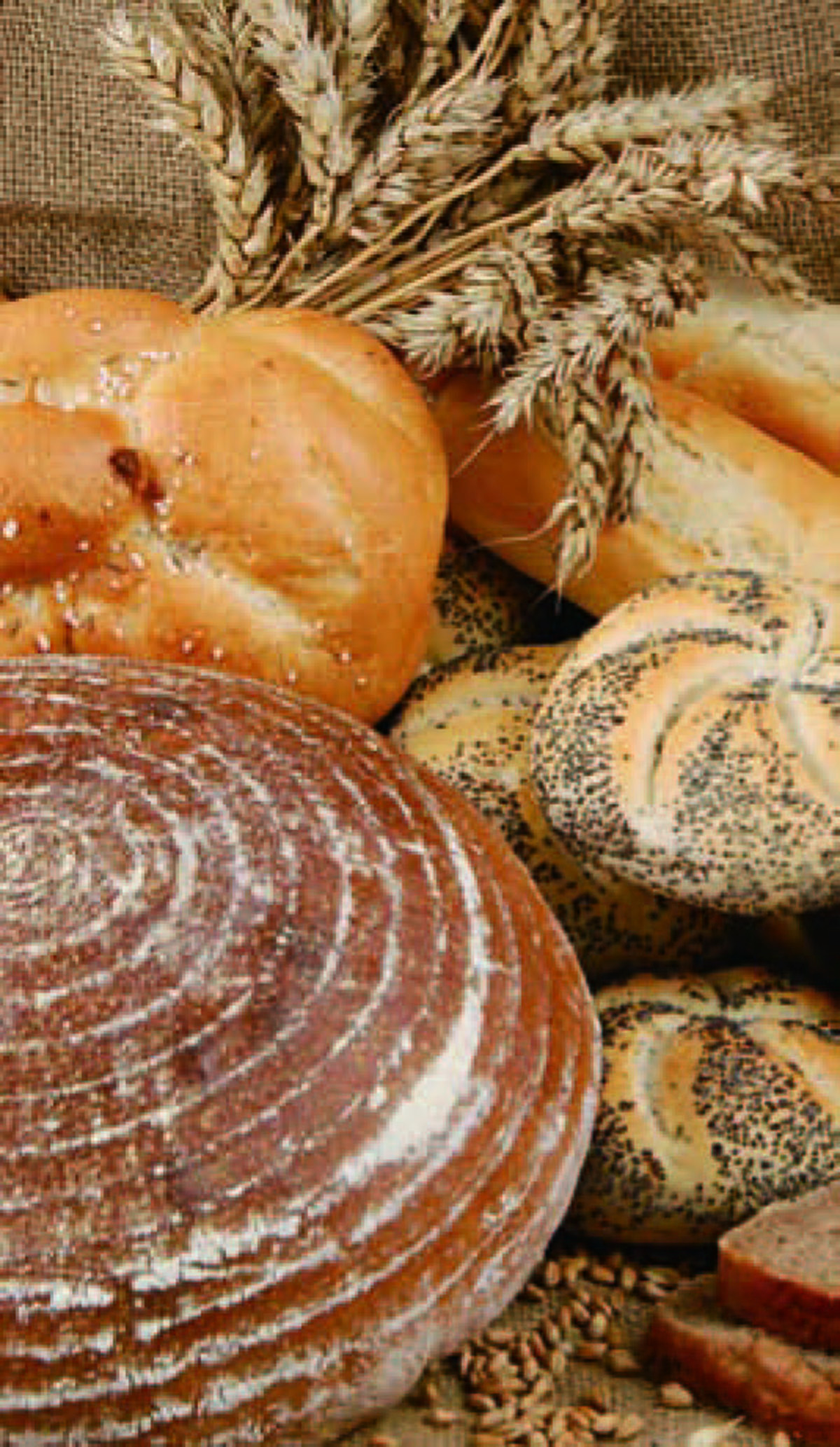
A white bread diet in combination with a regular meat diet (meat has no fibre) is a risky long-term diet, especially for colon health. One study showed that the ‘protective quantity’ of fibre, for adults, needs to be more than 28g a day. That’s 48 slices of white bread. Don’t loaf around with no fibre!
NOTE: All amounts in this book are measured in milligrams (mg) per 100 grams, unless stated otherwise.
| GLYCEMIC | C. P. L. | CALORIES – total: 339 kcal. per 100 grams |
| INDEX: 41 | 80 14 6 | Calories from: Carb: 269 Protein: 49 Fat: 21 |
WHEAT (PASTA)
Wheat is the main ingredient in pasta, and a special type of wheat—durum wheat—is used almost exclusively. The name ‘pasta’ implies a ‘paste’ with water and flour.
The main styles of pasta are: cannelloni, lasagne, macaroni, rigatoni, spaghetti, tagliatelle and vermicelli. Within these styles are numerous variations in size, shape, thickness, added ingredients, plus plain and wholemeal versions. Some pasta has egg added to the mix, ‘ al uovo’, but generally it is made from plain durum wheat.
Pasta and pizza are among the most common meals in the family home, not just in Italy but throughout the world. They are easy to make and numerous different ingredients can be added to make each ‘pasta/pizza night’ different. Pasta/pizza, on its own, has about the same protein (12.8g or 26% d.v.), same carbohydrate content (74g) and the same fibre ‘problem’ as white bread (2.4g). As it has a very low fat content (1.6g or 2% d.v.), a serve of grated cheese will balance the meal plus add stacks of calcium, especially if its Parmesan (1380mg). But cheese supplies no fibre so, once again, the addition of fibre-rich foods is really beneficial. One serve of Cheddar cheese (28g) will add 9.4g of fat—mainly saturated (6g) and mono-unsaturated (2.6g)—and as the approx.daily requirement is 60–80g, the cheese on top is good value for the active person.
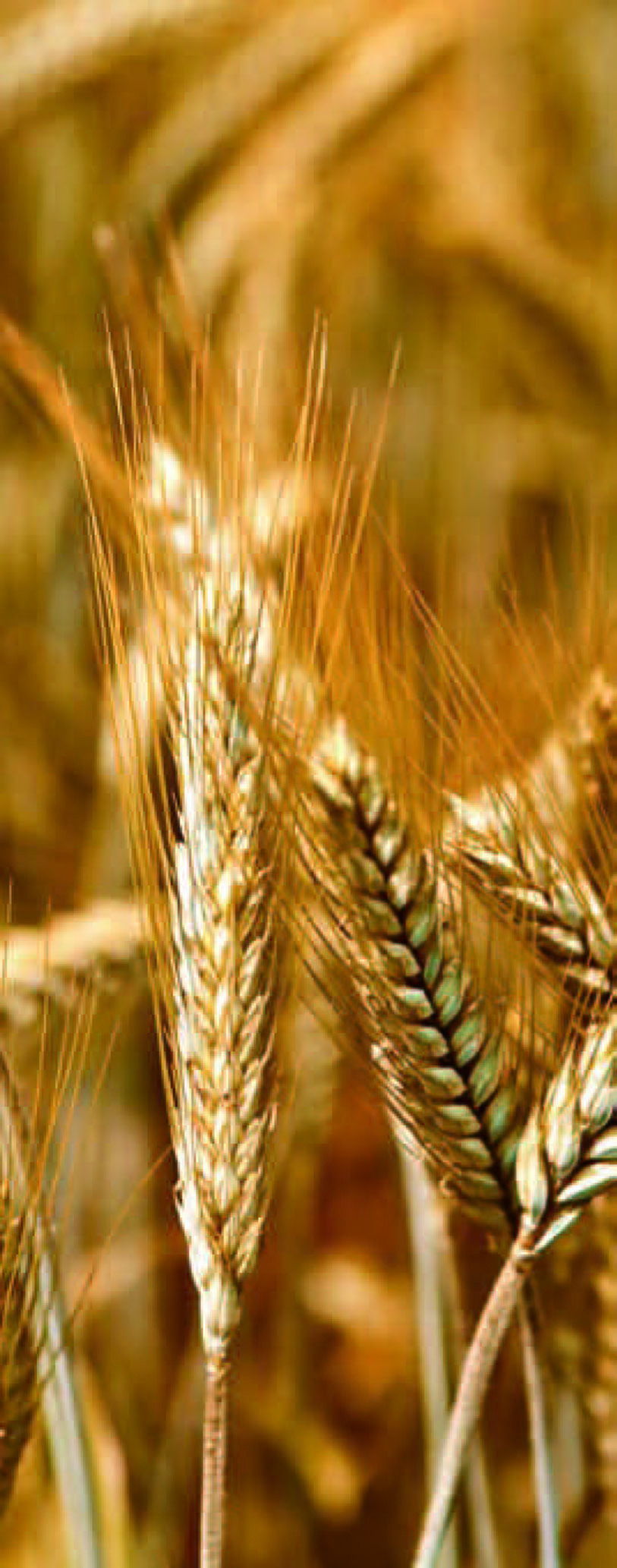
For children, pasta and cheese is great, but somehow throughout the day you must also provide them with fruit, or oats or wholegrain cereals, or add some baby spinach or a dash of bran into the tomato paste mixture, or serve it with yummy wholegrain bread and butter. The protein content of pasta (12.8g or 26% d.v.) is good and with the added protein content of cheese (25g) the protein increases to 38g, nearly 60% d.v. for adults and approx.80% d.v. for children. Now that’s big value for a growing family!
The main benefit of pasta and pizza is the excellent carbohydrate content (approx.72g or 25% d.v.). Both pasta and bread are energy-packed foods; however, as the body requires numerous nutrients to help utilise and produce the energy, the plain white pasta, pizza or bread on their own are fairly inadequate, due to a poor supply of essential nutrients. To overcome this problem, add ingredients that are full of nutrients. Pasta with mixed vegetables, Parmesan and a rich tomato sauce is basic but good nutrition.
For a top-quality pasta meal, add some ground pepitas on top of the cheese—‘I’ll have what she’s having!’ The same applies to noodles: add some stir-fried vegetables, blanched almonds or cracked or finely ground pepitas, and you can be sure of gaining great nutrition and additional flavour.
Foods such as pasta, pizza, noodles and bread can comfortably provide one-third of our daily energy values. We can get another third from fruits and vegetables and the balance from fats, oils and proteins. Pasta, bread and noodles provide approx.72g of carbohydrates per 100g. The daily average requirement for children and teenagers is approx.300–350g, for adults 300g. Our calorie requirements per day are children 2000, women 2200, teenagers and men 3000, an average person 2400 calories. Pasta or bread provides approx.340 calories per 100g serve. So always remember that it’s the topping that makes the bread, pasta, pizza or noodles healthful.

NOTE: d.v. refers to the daily value for women 25–50 years, refer to RDI chart for adult male and child values.
| C. P. L. | CALORIES – total: 361kcal. per 100 grams |
| 83 13 4 | Calories from: Carb: 299 Protein: 48 Fat: 14 |
WHEAT (FLOUR NUTRIENTS)
Wheat in the whole grain and as wholegrain flour is a power-packed food, the protein and carbohydrate value are well balanced and the supply of minerals (except calcium) and fibre is beneficial. The main problems with the white flour, bread, pastries, pizza and pasta products are: the low fibre content, as mentioned; the low calcium and phosphorus content, essential for the nerves, brain, bones and digestion; the low magnesium content, as magnesium is vital for the nerves, digestion, bones and brain; and the low potassium supply, as potassium is essential for the heart muscles, circulation and nerves. The iron content is fair, but the manganese content, vital for blood development, memory, glands and nerves, is deficient. The zinc content is low; zinc is vital for bone strength and growth, digestion, glands and hormones. The B vitamins are ‘added’ to enrich the white starch flour, but the vitamin E content is very low, and this vitamin is vital for the heart, healing, long life, antioxidation and fertility. The number of common ailments associated with the above nutrient deficiencies is enormous and white flour products can be a major contributor if they are the staple food in the diet. In addition, refined white bread includes additives.
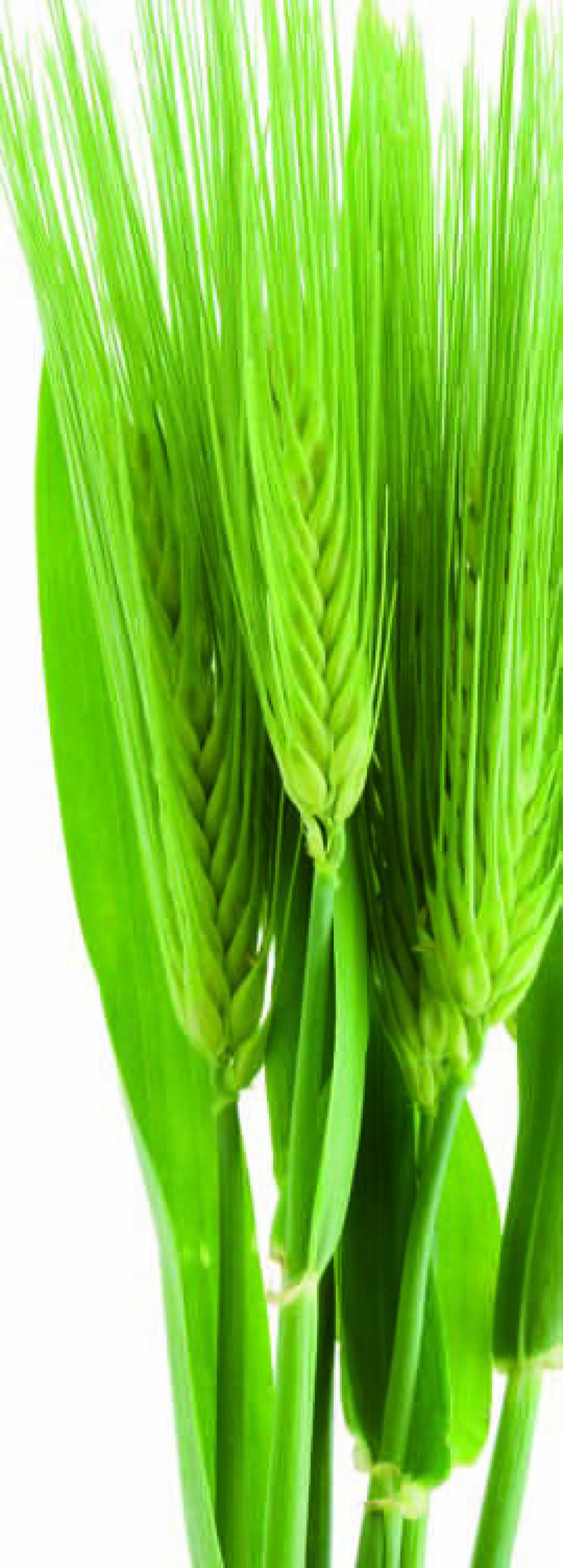
Refined white flour and products cannot stand alone nutritionally, they need added ingredients to ensure proper health. In addition, the high glycemic index of especially pretzels (80), white bread and muffins (70) adds further weight to the suggestion that beneficial foods need to be included with the white flour products. Ideally, whole grains such as oats can take the place of breakfast toast, or yeast extract can be added to the bread or toast, to give it a small boost for your nerves. Toast with tahini is great as the supply of vitamin E and minerals, plus protein, is excellent.
Let your bread be delightful, but healthful. Add natural ingredients to make the soft, spongy, white bread beneficial. May your daily bread be loaded with benefits and flavour.
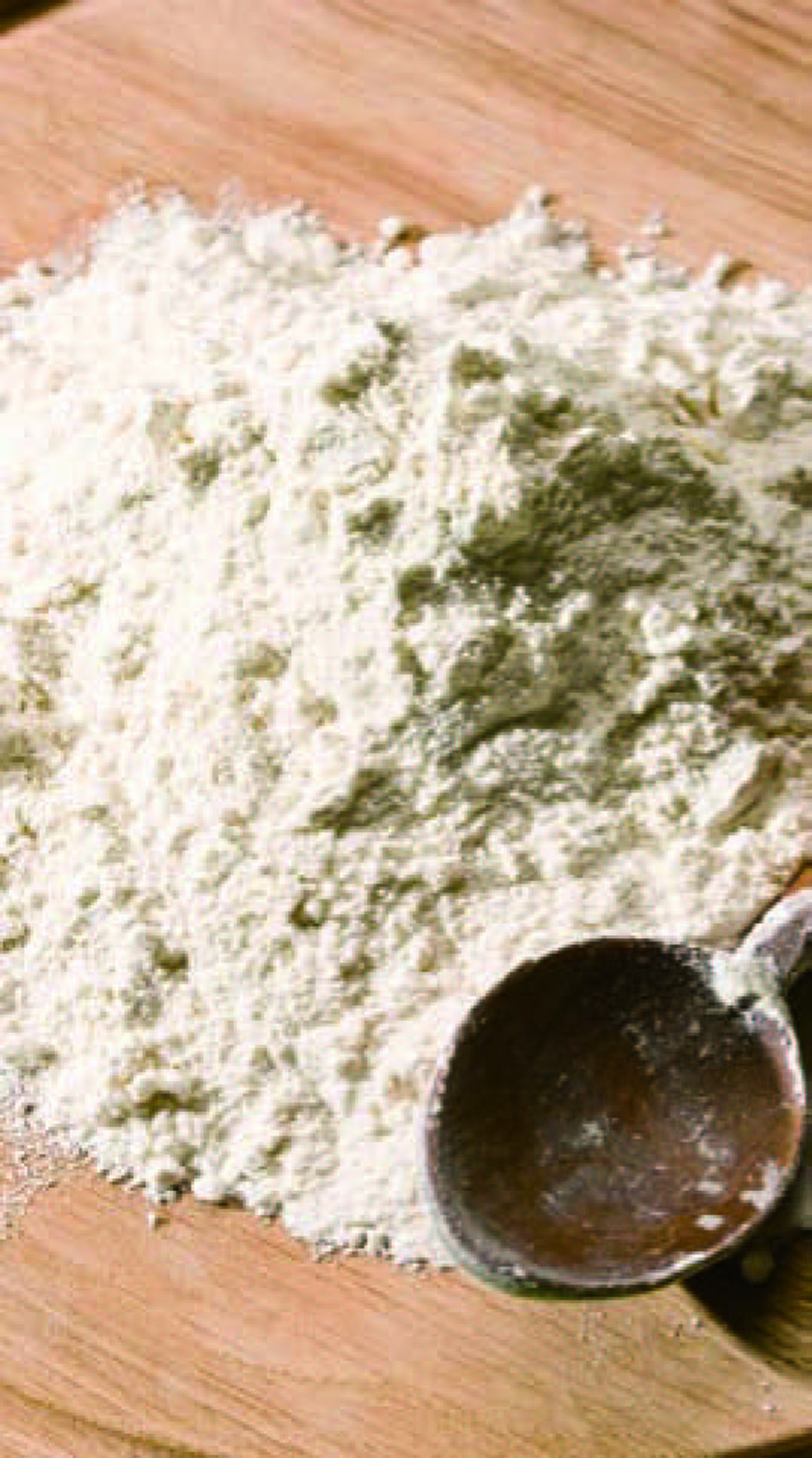
NOTE: All amounts in this book are measured in milligrams (mg) per 100 grams, unless stated otherwise.
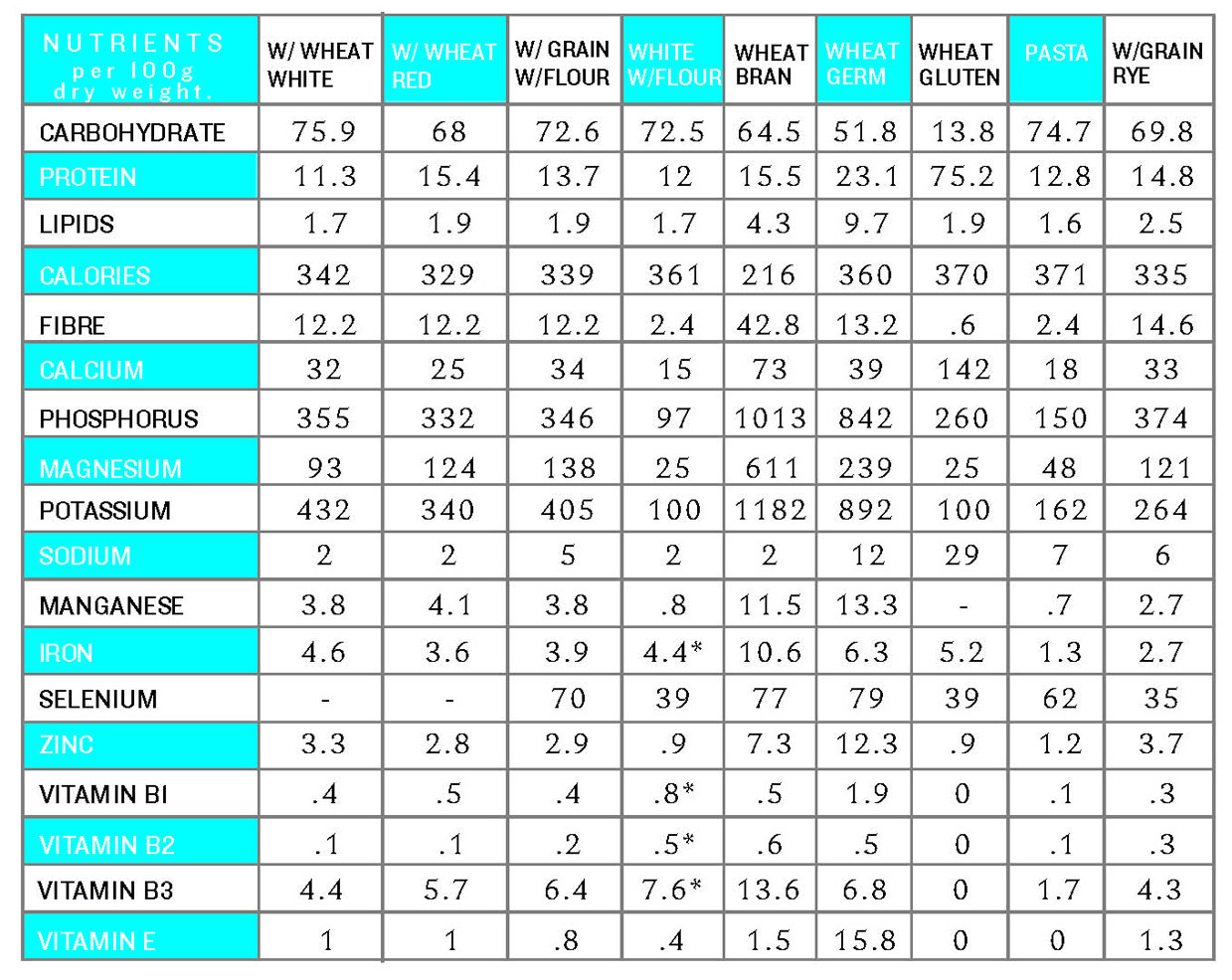
NOTE: All amounts in this book are measured in milligrams (mg) per 100 grams, unless stated otherwise.
|
WHOLE GRAINS |
MAIN NUTRIENTS, ANTIOXIDANTS & PHYTONUTRIENTS |
BODY SYSTEM BENEFITS |
|---|---|---|
| BARLEY | protects against colon cancer, arthritis, asthma, diabetes, high cholesterol | digestive, elimination |
| CORN-sweet | protects against infections, lung cancer, brain disorders, irritability | respiratory, brain |
| MILLET | silicon, iron, gluten free, yeast free, alkaline, folate, phosphorus, zinc, copper | digestive, repair |
| OATS | fibre, lowers blood sugar levels and cholesterol, ideal for diabetics, magnesium, antioxidants, protein | digestive, blood, brain, nervous |
| RICE-brown | alkaline, manganese, selenium, phosphorus, gluten free, yeast free | digestive, blood |
| RYE | fibre, low gluten, natural oestrogens, manganese, selenium, zinc | digestive, glandular |
| WHEAT | carbohydrates, fibre, potassium, manganese, selenium, vitamin E | muscular |
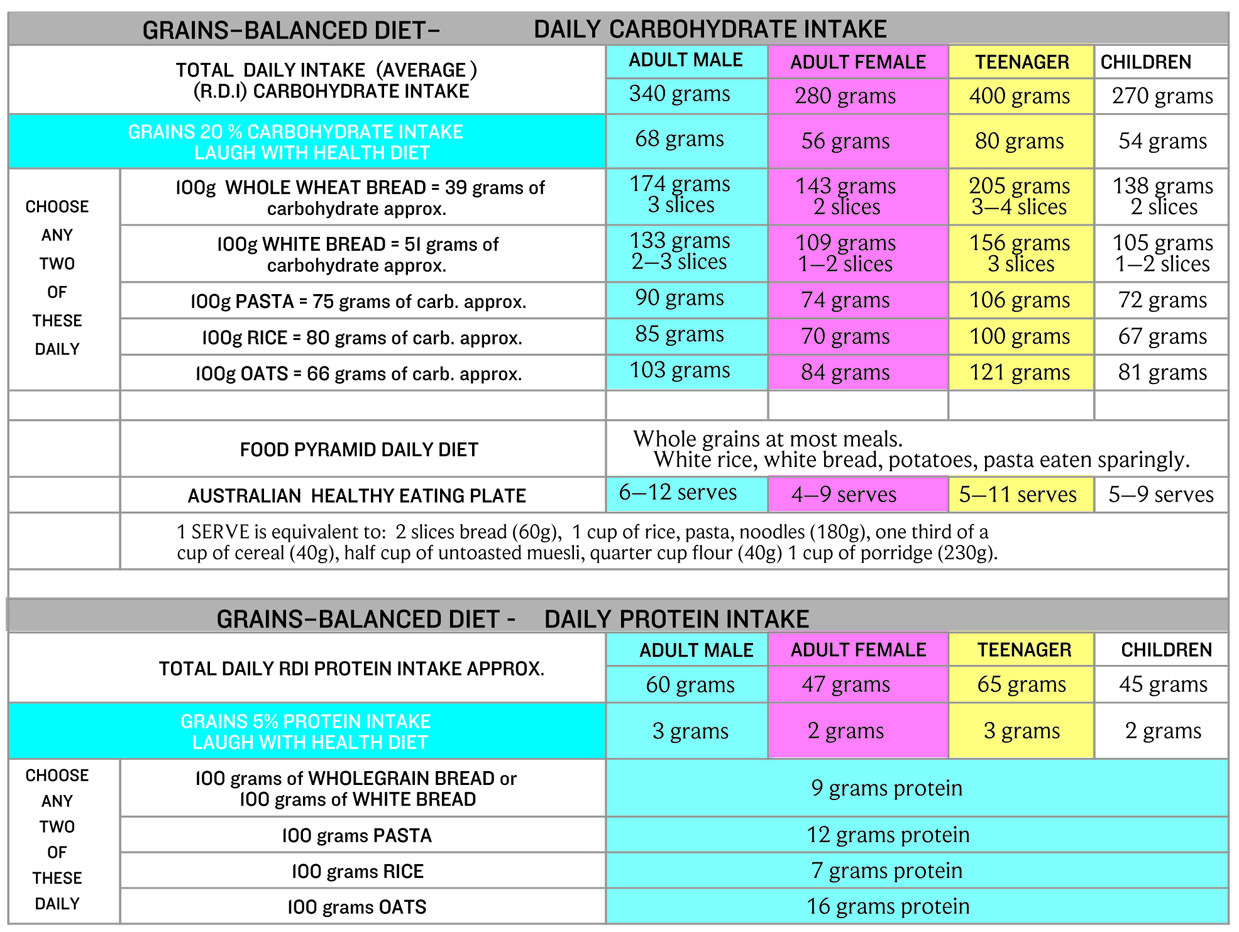
The above charts are provided as a guide to the daily amount of the individual food groups that are suggested by three different dietary guidelines: 1. Laugh with Health Diet, 2. US Food Pyramid Guide, 3. Australian Guide to Healthy Eating. These charts are provided as a guide only and are not to be considered for an exact daily intake. The main aim of these charts is to show that all the main food groups are required for a balanced diet. All three dietary guidelines suggest that a variety of foods be obtained on a daily basis, and over a period of one week a complete range of natural food groups can be obtained. Balance your life naturally!
NOTE: d.v. refers to the daily value for women 25–50 years, refer to RDI chart for adult male and child values.